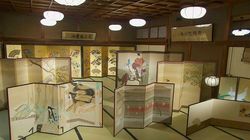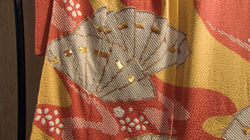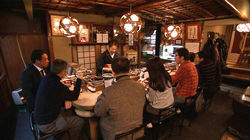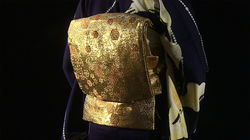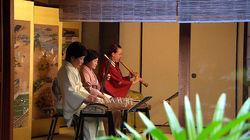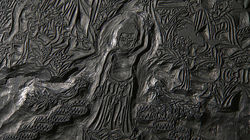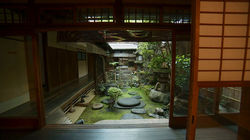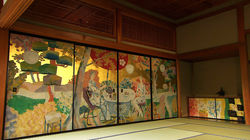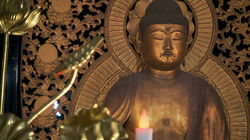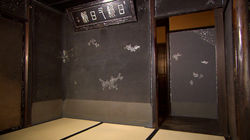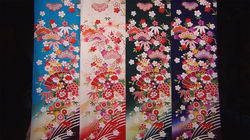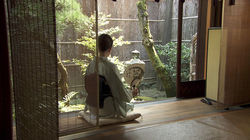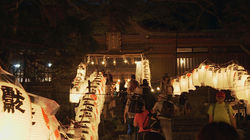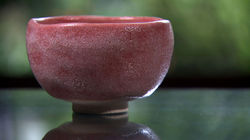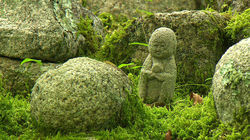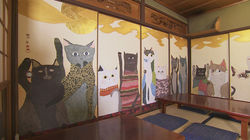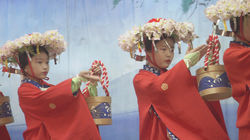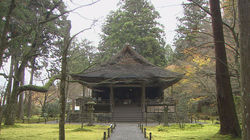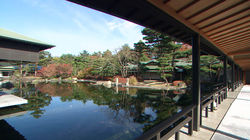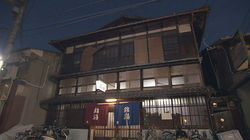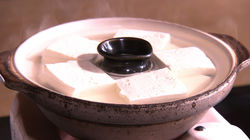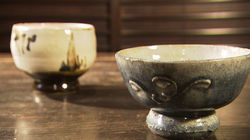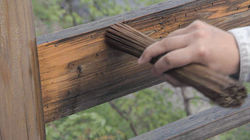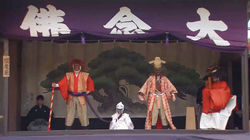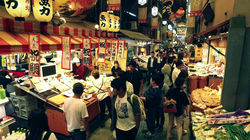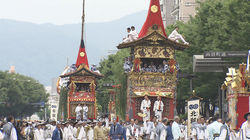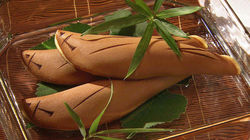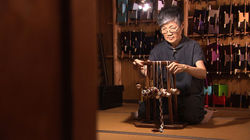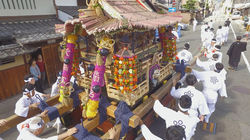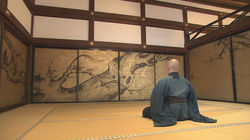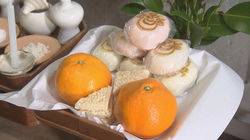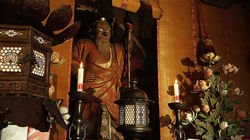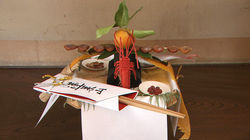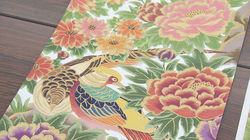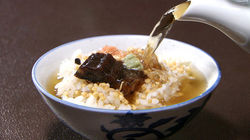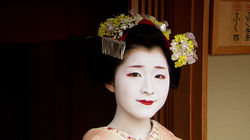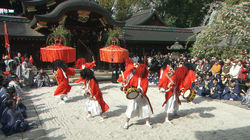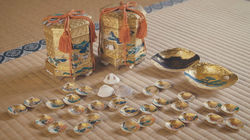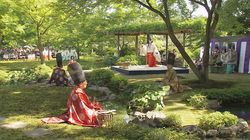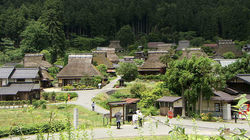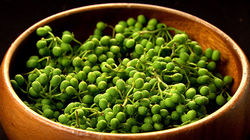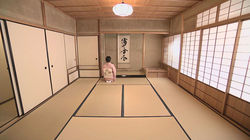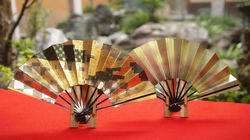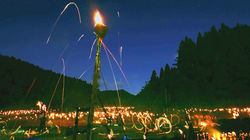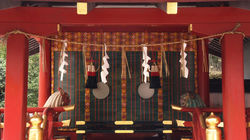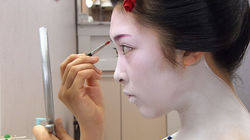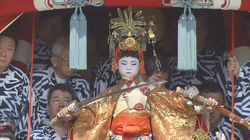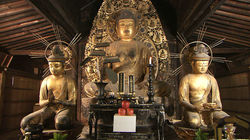Season 2013
Episode: 2013-02-27 | Airdate: Feb 27, 2013
Kyotoites have lived in kyo-machiya townhouses for centuries. Each year, 1,000 are demolished, but Kyo-machiya Sakujigumi, a group of craftsmen skilled in machiya restoration, use natural materials and traditional methods to preserve them. Megumi Hata, whose family kyo-machiya was built in 1869, discusses how living in a machiya means living comfortably in harmony with nature. Within their walls, the wisdom, the way of life and the spirit of Kyotoites remain unchanged through the generations.
Episode: 2013-04-04 | Airdate: Apr 4, 2013
Stimulating all five senses, kaiseki-ryori is a Kyoto culinary work of art. Eiichi Takahashi, 14th generation owner of Hyotei, stresses kaiseki's roots in cha-kaiseki meals served at tea ceremonies. Leading chefs and researchers explore new potential for kaiseki. Takuji Takahashi, 3rd generation owner of Kyo-ryori Kinobu, creates novel dishes using Western methods while preserving the form of Japanese cuisine. These inquisitive minds pursue the ultimate in culinary hospitality.
Episode: 2013-04-18 | Airdate: Apr 18, 2013
Kyoto has about 2,700 temples where an array of benevolent, meek, and ferocious Buddhist statues are worshipped. World Heritage temple Toji has a configuration of statues in an imposing, 3D mandala and a beautifully woven mandala, which captures the cosmos. The jizo statues standing on street corners have a special place in the lives and hearts of Kyotoites. Today, sculptors continue to breathe life into Buddhist statues, and skilled craftsmen create magnificent works using gold leaf in microns.
Episode: 2013-05-16 | Airdate: May 16, 2013
Various locations in Kyoto have been famous cherry-blossom-viewing spots for 1,200 years. As spring approaches, the locals' actions revolve around thoughts of hanami. The cherries keep family ties strong; 3 generations gather once a year for hanami festivities. A 3rd-generation cherry gardener who conserves cherry trees and a photographer who has snapped Kyoto's cherries for about 40 years talk about the enduring allure of these flowers, which feature in bento meals and embroidery designs. The blossoms uplift the hearts of Kyotoites who treat hanami as a special celebration.
Episode: 2013-06-06 | Airdate: Jun 6, 2013
Japanese-style paintings are the embodiment of Kyoto aesthetics. Their delicate scenes are created using unique mineral pigments. Flower artist Rieko Morita emphasizes life in her work. She infuses it with the vitality she feels within the flowers. Modern artists, like her, are grounded in a history that stretches back 1,000 years to the dynastic paintings of the Heian Period. All kinds of schools with distinctive styles were born throughout the long history. The Kano School of painting was favored by samurai. The Rimpa School was characterized by decorativeness. The Maruyama School stressed realism. Various traditions give Kyoto paintings diversity and allure.
Episode: 2013-06-13 | Airdate: Jun 13, 2013
The quality of hospitality found at accommodations in Japan's old capital, Kyoto, is known worldwide. They exude a time-honored culture and uniqueness. The entrances are cleansed with sprinkled water and the rooms have peaceful atmospheres with a seasonal touch of flowers. This ingrained sensibility is drawn from Shinto and Buddhist teachings. Once billeting monks, a Zen temple offers pilgrims' lodgings - the roots of Kyoto lodgings. Established inns uphold their founding standards. The essence of consideration that soothes travelers exists in diverse lodgings around the city.
Episode: 2013-06-20 | Airdate: Jun 20, 2013
The main stage for hospitality in the glittering Kagai entertainment district is the Ozashiki banquet. Geiko - as geisha are known in Kyoto - and maiko, or trainee Geiko, refine their skills over years in dance and other performing arts to present at Ozashiki. In this world, Shikitari customs and etiquette are dictated by strict protocol drilled into the girls by their elders in their daily lives. A Shidashiya caters meals for Ozashiki. A Yuzenshi dyer creates unique maiko kimono. Many people live within the culture at the heart of the Kagai.
Episode: 2013-07-04 | Airdate: Jul 4, 2013
The origin of Aoi Matsuri, one of Kyoto's 3 great festivals, goes back more than 1,400 years. Diviners advised the people to ride horses in prayer for bumper crops and to appease the Kamo deities, who were causing storms and floods. Emperors thereafter paid homage to Shimogamo Jinja and Kamigamo Jinja, and solemnly performed these now-ancient rituals that are reminiscent of the dynastic culture. Aoi Matsuri, its splendid parade and rare customs are full of mystery, even for Japanese.
Episode: 2013-07-18 | Airdate: Jul 18, 2013
Sen-no-Rikyu (1522-1591) began the chanoyu, or tea ceremony, that is practiced today, 400 years ago. His simple, rustic wabi philosophy is still discernable in the designs, movements and mindset. In Uji, Kyoto, the year's first shoots from shaded tea plants are ground into a fine powder to make the koicha tea used in the ceremonies. Artisans use time-honored methods to craft the chanoyu utensils. People immerse themselves in this art in which each bowl of tea is considered a once in a lifetime encounter.
Episode: 2013-08-15 | Airdate: Aug 15, 2013
Gion Matsuri began as a prayer for the country's health when 66 halberds were erected and 3 mikoshi shrines were paraded through plague-ravaged Heian-kyo in 869. The 33 yamahoko floats in today's climactic procession on July 17 are "moving museums". Revived in 1952, the Kikusui-hoko float was adorned this year with a new tapestry in gratitude to the ancestors. The festival music is traditionally taught orally. The floats are assembled with age-old technics. The streets are alive with revelry on the eve of the parade.
Episode: 2013-09-05 | Airdate: Sep 5, 2013
In the 1200's, the monk Dogen brought shojin-ryori, a vegetarian cuisine, from China along with Zen Buddhism, which forbids the killing of animals and the eating of meat. He once said, "Meals and their preparation are part of aesthetic training". Kaiseki-ryori and other Japanese cuisine have their base in and developed from shojin-ryori, which wastes nothing of the seasonal vegetables and cereals used. Chefs, including a chef at a Michelin-rated restaurant, work to spread shojin-ryori worldwide.
Episode: 2013-09-19 | Airdate: Sep 19, 2013
Kyoto has many mountain springs, rivers and groundwater. The capital relocated here about 1,200 years ago for the water supply that enriched the citizens' lives and gave rise to Kyoto's culture. Farmers grow vegetables in the fertile delta. Craftspeople continue the kurozome dying traditions. A namafu wheat-gluten store relies on quality groundwater. Supporting them are well sinkers with an extensive knowledge of groundwater arteries. Ever grateful, the locals use water as their livelihood.
Episode: 2013-10-03 | Airdate: Oct 3, 2013
As demand for lacquerware grew in the political and cultural hub of Kyoto, artisans refined their designs and techniques with a distinctive approach to aesthetic beauty. This became kyo-shikki, or Kyoto-style lacquerware. The maki-e drawing technique uses sprinkled gold dust on a jet-black background to reproduce dazzling Kyoto scenes. Modern sensibilities combined with traditional techniques produce innovative pieces. Lacquer and gold dust engender the lavish world of this traditional craft.
Episode: 2013-10-17 | Airdate: Oct 17, 2013
A pointed boulder with a large stone at its foot reaches for the heavens. The white gravel between them represents a swift flowing river, without the use of water. Karesansui is a unique dry-gardening style that developed in the 14th century from ascetic practices at Kyoto's Zen temples. Monks aim for enlightenment within a world of rippling patterns that run between curious rock arrangements. Enter the infinite Zen cosmos through the karesansui gardens at Tenryu-ji, Daisen-in and Ryoan-ji.
Episode: 2013-11-07 | Airdate: Nov 7, 2013
Nishijin-ori symbolizes the ancient capital's elegance and luxury. The obi-weaving process is divided into detailed tasks, such as mon-template design and yarn dying. Each artisan has a specialist role. With a deep sense of responsibility and a mutual trust, they strive for higher levels of perfection. Noh costumes have unsurpassable beauty. Some artisans weave with their fingernails. This magnificent textile meshes the city's 1,200 year-old history and the fervor of artisans through the ages.
Episode: 2013-12-05 | Airdate: Dec 5, 2013
The ancient capital has many shinise, or established businesses, with unbroken histories. Kyoto Prefecture classes a firm founded at least a century ago as shinise. Over generations, more than 1,100 Kyoto shinise have maintained imperial court culture and life; and provided for temples, shrines, samurai clans and the common people. Through the ups and downs, they have upheld their trade, reputations and family mottos; and kept the Kyoto entrepreneurial spirit of status and trust alive.
Episode: 2013-12-19 | Airdate: Dec 19, 2013
The changing leaves vividly color Kyoto, which lies in a basin and has marked temperature differences. For more than a millennium, people have delighted in their beauty and picnicked under the trees. Today, the changing leaves continue to enchant Kyotoites, who live within the changing seasons. The exquisite leaves adorn traditional kaiseki cuisine dishes, and the trees lit up at night are a magical sight. Some are so captured by their magnificence they express it in Waka poetry and the arts.
Season 2014
Episode: 2014-01-16 | Airdate: Jan 16, 2014
Kyoto confections are Wagashi, or traditional confections, infused with Kyoto's charm and influenced by the tea ceremony. With beautiful designs and names that subtly reflect the seasons, tea confections are an art form to be appreciated with the 5 senses. When making these confections, importance is placed on the semblance and name they are given. Inspiration is drawn from local nature, art, music and literature. Feel Japan's culture, nature and climate through flavorsome Kyoto confections.
Episode: 2014-02-06 | Airdate: Feb 6, 2014
Traditional washi paper flourished in the temples, shrines and palaces of the ancient capital. Enduring today, this versatile paper is used to decorate interiors, such as sliding doors and hanging scrolls. Kurotani has been the papermaking center of Kyoto washi for 800 years. Katazome-washi is dyed with traditional yuzen-dyeing patterns. Useless washi and centuries-old books are used in recycle-themed artworks. The efforts of Kyoto's artisans and artists nurture Kyoto's washi culture.
Episode: 2014-02-20 | Airdate: Feb 20, 2014
Obanzai are the frugal side dishes that grace dinner tables daily in Kyoto - the home of washoku, or Japanese cuisine. Cooked to make the staple dish of rice taste delicious, they use only simple ingredients. The wisdom in the preparation is eco-friendly; scraps are reused, none are discarded. The menu handed down in the Sugimoto clan for more than 200 years embodies the spirit of obanzai. Washoku was added to UNESCO's Intangible Cultural Heritage list in 2013, and obanzai is in the spotlight.
Episode: 2014-03-27 | Airdate: Mar 27, 2014
Ikebana is the traditional art of flower arranging. Developed in Kyoto it merges Asian naturalism with the floral offerings to Buddhist altars. The Ikenobo headmaster upholds the school's 550-year-old tradition. A potter imagines vases as extensions of the flowers they hold. A practitioner creates progressive arrangements steeped in tradition. Plants are not mere ornaments. Practitioners impose their lives on that of the flowers. Ikebana's quintessence is in the representation of life as beauty.
Episode: 2014-04-03 | Airdate: Apr 3, 2014
Calligraphy is the art of writing characters with a brush. The use of kanji characters, which entered from China, spread with the practice of copying sutras. In temples and shrines, the art projects the state of the practitioner's mind. Calligraphy developed independently through the kana syllabary 1,200 years ago. Kana calligrapher Koho Hibino, master of a flowing style, says it embodies Japanese emotional and aesthetic sensibilities. Discover the essence of the black-and-white realm of calligraphy.
Episode: 2014-04-17 | Airdate: Apr 17, 2014
The butsudan Buddhist family altar was built as a miniature of the temple dais upon which the main image stands, so families could worship at home. Reflecting the Pure Land in this world, butsudan not only hold Buddhist images but are also vehicles for people to communicate with their ancestors. Kyoto altars, called kin-butsudan, are decked with gold metalwork and maki-e lacquer. Their beauty is an unparalleled work of art. Strongholds of the heart, kin-butsudan show the core of Kyoto culture.
Episode: 2014-05-01 | Airdate: May 1, 2014
Tawaraya Sotatsu, who emerged from Kyoto's merchant class, was one pioneer of the Rimpa School in the early Edo Period, and Ogata Korin consolidated it in the mid-Edo Period. The school is not hereditary but is propagated by artists, who admire Sotatsu and Korin, and follow their styles. Rimpa is characterized by a notable use of space; abstract, vibrant designs; and creative playfulness. The works of Kyoto-based Nihonga artists continue the Rimpa style 400 years after its inception.
Episode: 2014-05-15 | Airdate: May 15, 2014
Kyoto has long-been a leading bamboo-growing region. Bamboo was considered holy in ancient times for its strong vitality. It is used at shrines and palaces as the barrier between the sacred and secular worlds. Gagaku music for the deities is played on bamboo instruments. Since Heian times, this durable, pliable material was important in the development of Japanese architecture in Kyoto, such as garden gates and fences. Bamboo also appears in various capacities in the diet and clothing of Kyoto.
Episode: 2014-06-05 | Airdate: Jun 5, 2014
Kyo-yuzen fabric has distinct patterns and splendid, delicate colors. Kyo-yuzen dyed kimono brighten special occasions in Kyoto. A lady takes extra care of her grandmother's kimono that is filled with joyous memories. An established wholesaler and its skilled artisans resolutely provide the ultimate in kyo-yuzen. An artist, whose one aim is to make women shine beautifully, breathes life into kyo-yuzen. Admire the beauty of Kyoto attire through kyo-yuzen, nurtured by a refined eye for beauty.
Episode: 2014-06-19 | Airdate: Jun 19, 2014
Filled with noble, graceful dignity, Kyoto dolls have long embodied people's prayers, relieved loneliness, and represented prayers for their children's growth. Connected to dynastic culture, these dolls evolved in the hands of talented Kyoto artisans. Edo-period craftsmen honed their doll-making skills, and these techniques are still practiced. Hina dolls reflect adoration for the nobility. Gosho dolls were adored at the palace. Find out how people's hearts are connected through Kyoto dolls.
Episode: 2014-07-03 | Airdate: Jul 3, 2014
Kyoto is home to most Buddhist head temples, which shaped the ancient capital's historical landscape and fascinate visitors. Shichido-garan, the 7 most important buildings for Zen religious training, are positioned in the shape of a person. Maintaining temples for centuries, carpenters conduct major repairs at Chion-in and thatch Kiyomizu-dera's main-hall with cypress bark using traditional roofing methods. Look at the world of Buddhist architecture, sustained by craftsmanship and faith.
Episode: 2014-07-17 | Airdate: Jul 17, 2014
Shinto shrines have sacred shimenawa ropes, bells with cords attached, mirrors, various fittings, and ceremonial ornamentation that have adorned these places of worship since time immemorial. Made from wood, metal, silk threads, hemp, and other materials, this ornamentation became more elaborate and brilliant in the hands of artisans who gathered in the ancient capital, Heian-kyo, when it was established some 1,200 years ago. These crafts, which live on today, link worshippers with the deities.
Episode: 2014-08-07 | Airdate: Aug 7, 2014
The Kyoto basin is blessed with fertile soil and an abundant supply of good water. Kyoto winters are frigid; and summers, scorching. This environment yields eggplants, pumpkin, and other produce known as 'Kyoto vegetables', many of which have been grown for more than 150 years. One local farmer works to promote new varieties, while students try to revive an almost extinct variety of gourd. Discover the allure of nutritional, flavorsome Kyoto vegetables in the hands of various chefs.
Episode: 2014-09-04 | Airdate: Sep 4, 2014
Ogres, specters, demons, ghosts and hell. The ancient capital's many myths of the spirit world seem fantastic today. Kyoto's citizens lived in fear and awe of the other world and appealed to the deities for help. They honored milestones and kept the annual events in thanks to the deities for their protection. Consequences of the city's prosperity, the legends have origins in the deep in the recesses of the human mind, and the epidemics and wars that occurred throughout Kyoto's history.
Episode: 2014-09-18 | Airdate: Sep 18, 2014
The Japanese believe their ancestors' spirits return from the other world to visit during Obon in mid-August. The Gozan-no-okuribi ceremony to send them off is held in Kyoto at the end of Obon on August 16. Bonfires are lit on five Kyoto mountains as guides for the spirits to find their way back safely. Watch the locals' prepare for this fiery traditional event in the Matsugasaki area of Kyoto, where two of the bonfires are lit, and discover the ancient customs of the living and the dead.
Episode: 2014-10-02 | Airdate: Oct 2, 2014
Fushimi Inari Taisha is famous worldwide for the vermillion shrine gates that line the paths in the mountain behind it, where its origins lie. Worshippers seeking happiness have visited this sacred ground where the deities rest for centuries. One family prays religiously every month for business prosperity. Another has the divided spirit of the deity protecting their home and business. Kyotoites live for the future, every day in thanks, through the shrine that embodies their unwavering faith.
Episode: 2014-10-16 | Airdate: Oct 16, 2014
Noh is one of the oldest, extant performing arts and is a UNESCO Intangible Cultural Heritage of Humanity. It has been performed in Kyoto some 650 years, and its form remains largely unchanged. Through few moves and props, the plays portray human drama around age-old themes, such as love and parent-child bonds. Protagonists are mostly spirits of the dead telling of their earthly grief and joy. Within the seemingly expressionless masks lies a subtle beauty, drawing spectators into a dream world.
Episode: 2014-11-06 | Airdate: Nov 6, 2014
Dynastic culture thrived some 1,200 years ago in Heian-kyo, heavily influenced by mainland Asian, especially Chinese, culture. Over time, it developed its own idiosyncrasies and permeated all aspects of life: clothing, architecture and food. The invention of the kana syllabary spawned waka poetry, essays and novels. For 800 years the Reizei clan has kept the waka traditions and other aristocratic rituals alive. The roots of today's Japanese culture can be seen in elements of dynastic culture.
Episode: 2014-11-20 | Airdate: Nov 20, 2014
Gardens are miniatures of nature. The first ornamental gardens go back to the 8th century. The Heian nobility held events, rituals and pleasure-boat parties in their gardens. The structure of Kyoto gardens changed over the centuries, copying landscapes. In the late 19th century, garden designer Ogawa Jihei constructed an expansive garden that captures the view of Kyoto's mountains. Discover Kyoto's horticultural culture through the work of a modern garden designer, a plantsman and a mason.
Episode: 2014-12-04 | Airdate: Dec 4, 2014
Kyoto boasts upwards of 1,000 shinise businesses, each more than 100 years old, many of which are in the food industry. Kyoto cuisine is the foundation of washoku Japanese cuisine, and these shinise are its core. Their trade names, signboards and noren curtains convey the philosophy and principles of operating a shinise. The spirit of the artisans focuses on honoring traditional skills and conventions while concentrating on the future. Discover Kyoto's culture through its timeless food culture.
Season 2015
Episode: 2015-01-08 | Airdate: Jan 8, 2015
Around 400 years ago, Sen-no-rikyu pursued the art of heart-to-heart communication through a bowl of tea and advanced the wabi-cha style of tea ceremony, stressing the beauty within simplicity. The utensils are vital in conveying the hosts' sentiments. The essence of wabi-cha pervades the utensils made by 10 artisan families, purveyors to the Sen clan. Watch these artisans at work in a range of crafts from lacquerware to joinery and discover the spirit and aesthetic sensibilities of Kyoto.
Episode: 2015-01-22 | Airdate: Jan 22, 2015
Kyoto tsukemono, or pickles, are made with various combinations of pickles and agents to preserve seasonal vegetables. Of these, three major varieties are still made using unique methods. Suguki turnip pickles, once made by Shinto priestly clans, have a rich, sour taste. Shibazuke pickled eggplants have the reddish hue of shiso leaves. One family makes senmaizuke white-turnip pickles with a special recipe. Discover the wisdom and skill accumulated over centuries that make vegetables tastier.
Episode: 2015-02-26 | Airdate: Feb 26, 2015
February 3 is New Year's Eve by the old, lunar calendar and is the boundary between winter and spring. On this day, called Setsubun, households scatter soybeans for good fortune in the coming year, expelling the demons that represent misfortune and calamity. The shrine Yoshida Jinja protects Kyoto at the 'demon's gate' in the northeast with a ritual in which the 'shaman' wears a four-eyed mask. Farmers in rural areas uphold the custom of driving out moles. Disguised geiko pray for protection against evil. Discover how Kyotoites pray for order in life through these safeguarding traditions.
Episode: 2015-03-19 | Airdate: Mar 19, 2015
In the ancient capital, sake was for religious and imperial rites. Made exclusively at the imperial brewery, the process evolved under the influence of palace cuisine. Kyoto with its bountiful water supply is ideal for production, and Fushimi later prospered as the sake brewing area. Gaining attention with the popularity of Japanese cuisine, sake is one of few alcoholic beverages in the world served hot or chilled. Discover the brewing process and the influence Kyoto sake had on Japan's culture.
Episode: 2015-04-01 | Airdate: Apr 1, 2015
Kyotoites have an affinity for the kimono that shares deep ties with traditional culture. A kimono researcher explains its aesthetics and the wisdom within this traditional clothing. The obi is an infinite expression of beauty. Wearing white socks is a sign of purity. Generations wear the same kimono, because it can be re-sown. Men's kimono exude style with lavish patterns in the coat lining and the family crest on formalwear. Discover the world of kimono, imbued with Kyoto's sensibilities.
Episode: 2015-04-15 | Airdate: Apr 15, 2015
After the first cafe opened in Kyoto in 1930, a coffee culture flourished as coffee salons enjoyed the patronage of local merchants, who prided themselves on staying abreast of the latest fashions. Kyotoites always placed the utmost importance on hospitality. Cafes may be relatively new to the cityscape, but they exude the local spirit of hospitality. Owners of distinct cafes find ingenious ways to infuse their service with this ethos. Discover the charm of Kyoto cafes while sipping on a brew.
Episode: 2015-05-06 | Airdate: May 6, 2015
Kannon Bosatsu is warmly worshipped, a comfort for the heart. The subject of many paintings and statues, he saves people across Buddhist sects. The 11-faced Kannon faces each direction in search of people to save. The 1,000-armed Kannon holds objects used to relieve people's anguish. Kiyomizu-dera, where memorial services are held for him, attracts worshippers seeking salvation. Watch a sculptor carve a statue of Kannon. Discover the deep faith Kannon has drawn among Kyotoites over centuries.
Episode: 2015-05-20 | Airdate: May 20, 2015
In the late 1800's Kyoto architects and builders were the first to embrace change as Japan modernized. They incorporated the unusual Western designs into their buildings, changing the cityscape with its many temples and shrines. The great achievements of these pioneers remain today, used as public institutions, places of learning, worship and business. Conspicuous yet congruous, they represent the dawn of a new era. Discover the modern architecture in the ancient capital, whose colors never fade.
Episode: 2015-06-03 | Airdate: Jun 3, 2015
Kyogen is a traditional performing art, popular in Kyoto for more than 600 years. Noh evolved at around the same time and draws many of its tragic plots from historical events. But Kyogen is more accessible, because it uses the vernacular and draws humorous themes from everyday situations, such as blunders and marital tiffs and other events. The Shigeyama family has been active in the art since the early 1700s. Mibu Kyogen evolved as religious drama. Discover the Kyoto's culture of laughter.
Episode: 2015-06-17 | Airdate: Jun 17, 2015
The decorative arts evolved throughout during the city's 1,200-year history and survive today. Kyoto's reputation commands the highest quality, and many works of stunning beauty emerged as artisans refined their techniques and aesthetic sensibilities. With strict attention to detail, the artisans devote themselves to and project their sensitivities onto each piece they create. Discover the pinnacle of Kyoto beauty as seen in the supreme decorative arts of Kirikane, Shippo, Kyo-nui and Raden.
Episode: 2015-07-15 | Airdate: Jul 15, 2015
Kyoto is home to many Buddhist and Shinto head temples and shrines. The approaches to the gates have long attracted vendors plying local specialties to worshippers. Kiyomizudera Monzenkai was formed by vendors along Kiyomizu-dera's approach as a vigilante group to protect the temple. When Nishihongan-ji was established 400 years ago, a "temple town" developed near its gates, and it thrives today with stores selling Buddhist items. Toji's Kobo Market connects the hearts of everyone who gathers.
Episode: 2015-07-29 | Airdate: Jul 29, 2015
Shidashi-ryori is Kyoto hospitality. Kyotoites do not serve visitors and honored guests homemade dishes on ceremonial occasions. The convention is to entrust the preparations to trusted caterers. The caterers fulfill their customers' needs, be they budgetary or ingredients. Caterers in different districts specialize for the local clientele: shojin-ryori for temples, kaiseki for tea gatherings, courses for entertainment districts. Discover bento meals and other various forms of shidashi-ryori.
Episode: 2015-08-12 | Airdate: Aug 12, 2015
The ancient capital was devastated during a period of intense war lasting 2 centuries until the late 16th century, when Toyotomi Hideyoshi assumed supreme power. He envisioned rebuilding a city that would prosper through a free economy and a stable government. A rampart was built around Kyoto, and rezoning increased residential areas. Hideyoshi's palace of gold was a symbol of his glory, and he influenced the lavish Momoyama culture. Discover the traces of Hideyoshi's legacy in Kyoto, today.
Episode: 2015-09-02 | Airdate: Sep 2, 2015
For Heian aristocrats some 1,200 years ago, Kyoto life was the world of officialdom. Uji, located southeast of the capital, was the retreat where they let their bodies and minds run free. It represented the transience of the material world as depicted in the classic novel, The Tale of Genji. The nobles embraced Uji-grown tea, which sustained the tea ceremony, and the pastime of cormorant fishing, and gave them form. Byodo-in was later built by the Jodo Sect to represent the Pure Land of Buddha.
Episode: 2015-09-17 | Airdate: Sep 17, 2015
Kyoto cuisine evolved in the old capital to please aristocratic eyes and palates. The local soft underground water inspired a cuisine that draws out flavors using dashi stock. Seafood was geographically hard to get, so locals refined techniques and contrivances, and the use of seasonings and utensils, for making tasty dishes with the available produce. Artisans provide quality products to maintain this food culture. Discover how the chefs' attention to detail brings out the ultimate in flavors.
Episode: 2015-10-01 | Airdate: Oct 1, 2015
Over its 1,000 year history as capital, Kyoto attracted craftsmen with outstanding artistry from around Japan. They made quality implements and furnishings, and the craft developed a distinct Kyoto refinement that became renowned. The craftsmen's knowledge of wood they work and their command of the delicate processes convey the traditions that survive to this today. Discover how various Kyoto woodcraft traditions evolved by watching the turners, joiners, coopers and other craftsmen at work.
Episode: 2015-10-15 | Airdate: Oct 15, 2015
Iwashimizu Hachiman-gu lies in the southwest of Kyoto Prefecture. On September 15, this shrine holds the Iwashimizu-sai. This some 1,000-year-old festival is held in prayer for the peace of all living things. In the darkness at 2 a.m., the mystical ritual begins with three mikoshi portable shrines, on which the deities ride, departing down the mountain. The scene is a living manifestation of ancient picture scrolls. Discover the Kyotoites' respect for life through this festival's rituals.
Episode: 2015-11-05 | Airdate: Nov 5, 2015
The Inoue School of Dance evolved as a distinct form of traditional Japanese dance in Kyoto. Danced to a shamisen and song backing, it developed exclusively for the geiko and maiko of Gion Kobu, Kyoto's largest entertainment district. Traditional Kyoto dance, or Kyo-mai, exalts life and can represent urbane people by acting out the universal emotion of females. Discover the consummate art of Kyo-mai with its history of more than 200 years through the current 5th head of the Inoue School.
Episode: 2015-11-19 | Airdate: Nov 19, 2015
Kyoto today is a bustling tourist destination, but there was a time when it had lost its sparkle. The emperor moved to Tokyo 120 years ago to forge a modern state, and many followed, depleting the population. This crisis shook the city's foundation, but it reinvented itself through modern public works and other initiatives. The Jidai Matsuri pays homage to the past with 2,000 people parading in period costumes. Discover the citizens' resilience as they redefined their city, creating a new Kyoto.
Episode: 2015-12-03 | Airdate: Dec 3, 2015
Byobu, or folding screens, were introduced to Japan in the 7th century as room partitions and windbreaks. Their distinct form today was shaped by Heian lifestyles and sensibilities, and they were elevated to an art form. Byobu are used to indicate the seasons. Gold screens grace formal receptions. Japanese artists are still drawn to them as a medium, and they produce byobu for religious and secular uses. Mounters uphold age-old techniques to restore them. Discover the profound allure of byobu.
Season 2016
Episode: 2016-01-07 | Airdate: Jan 7, 2016
Kyo-yaki, or artistic ceramics fired in Kyoto, evolved within the rich culture of the ancient capital as crockery for the local cuisine and as utensils in tea ceremony. One potter, who devotes his life to overglaze enamels, renders refined patterns and colors on his pieces. Another has refined his molding skills and creates pieces that are easy for chefs to use. These ceramics embody the Kyotoites' desire to please their guests. Discover how the charm of Kyo-yaki ceramics grows with use.
Episode: 2016-01-21 | Airdate: Jan 21, 2016
Suiseki is the appreciation of natural stone shapes using poetic imagination to visualize magnificent mountain, island or waterfall landscapes. This pastime arrived from China in the late 1100s and spread among Kyoto aristocrats and Zen monks. Suiseki's beauty lies in the stones' understated simplicity and becalming quality. The Seven Stones of Kamo found in the Kamo River basin are prized in suiseki circles. Discover the profound world of rock appreciation that evolved in the old capital.
Episode: 2016-02-18 | Airdate: Feb 18, 2016
Kyo-kanoko shibori is the general term used for tie-dyed fabric made in Kyoto. The bumpy pattern on the fabric's surface is mesmerizing with its delicate shadows. Binding parts of the fabric to leave undyed areas allows certain colors to bleed and lends the design solidity. Each stage in the process has its own specialized artisan for design, binding, dyeing, and other stages in between. Discover the alluring world of Kyo-kanoko shibori through the dexterous hands of passionate artisans.
Episode: 2016-03-03 | Airdate: Mar 3, 2016
The streets of Kyoto are dotted with many cozy-looking restaurants, which some may feel awkward about entering. Many of these small restaurants, referred to as koryoriya, specialize in Japanese cuisine. The owner-chefs behind the counter, who take the orders personally, pride themselves on serving food that complements the drink, and vice versa. So koryoriya are places to enjoy good food, good drinks and good conversation. Discover the allure of Kyoto's food culture and how to enjoy koryoriya.
Episode: 2016-04-07 | Airdate: Apr 7, 2016
The obi sash is an integral accessory for the kimono. One company has produced opulent Nishijin-ori obi for more than 120 years. A lady conveys the obi's allure through fitting classes. A dresser deftly ties the trailing obi of the Gion maiko. Fastened with a decorative cord, the obi is the final touch in a kimono ensemble. Its form manifests the obi's rich history and the sentiments of the people who produce or tie them. Discover the profound world hiding in a beautiful obi and its knot.
Episode: 2016-04-21 | Airdate: Apr 21, 2016
The world's oldest orchestral music, gagaku was imported from mainland China in ancient times. The melody is not based on a scale, yet the tunes are gentle, unmetered tones of continuous notes. The shakuhachi flute is a Buddhist instrument that brings enlightenment. The koto zither was much loved among the ancient aristocracy. The guitar-like shamisen entertains banquet guests in the flower districts. Discover the eternal tunes that harmonized the musical instruments' nature with human emotions.
Episode: 2016-05-05 | Airdate: May 5, 2016
Traditional woodblock prints in the ancient capital have a strong, distinct history. Their origins lie in the woodblock printing of Buddhist scriptures. Compared to the mass production of ukiyo-e prints that were popular with Edo (now Tokyo) residents, woodblock printers in Kyoto were more focused on quality over quantity, creating delicate, soft expressions of art with their honed skills. Discover the subtle, elaborate beauty through the expertise of the 3 artists involved in process.
Episode: 2016-05-19 | Airdate: May 19, 2016
Traditional Kyoto machiya townhouses have narrow entrances, and are long and deep. At the back lie small tsubo-niwa gardens, enclosed on all sides. Originally serving to light and ventilate the house, they enabled residents to comfortably endure the intense, summer heat. Over time, people applied their simple, austere aesthetic sensibilities to create beauty in these confined spaces. Discover the wisdom behind these gardens through the local lifestyle and the expertise of the landscape artists.
Episode: 2016-06-02 | Airdate: Jun 2, 2016
Kyoto artist Insho Domoto was prolific in the mid-20th century. He painted more than 600 dynamic sliding door paintings for Tofuku-ji, Chishaku-in and other major Buddhist temples in styles ranging from traditional Nihonga painting to innovative abstract painting. He has influenced a range of fields, such as sculpture, architecture, and the designs of traditional confectionery and accessories. Discover how "innovation is tradition" in Kyoto through works that reveal Domoto's creative spirit.
Episode: 2016-06-16 | Airdate: Jun 16, 2016
During the spring and fall tourist seasons Kyoto's shrines and temples open their usually hidden treasures to the public. The Buddhist statues and paintings, and other precious cultural assets that have survived centuries are threatened by degeneration, so special exhibitions are held to raise funds through entrance fees for repairing and preserving the objects. Discover Kyoto's fervor for preserving its cultural assets through the hidden treasures exhibited in Fushimi in spring 2016.
Episode: 2016-07-07 | Airdate: Jul 7, 2016
The ancient capital's dignified air of yesteryear is in part generated by earthen walls: the walls of the imperial palace, shrines, temples and even private properties. Earthen walls imbue tea houses with a rustic air. Kyoto is blessed with soil of a color ideal for these walls. Plasterers over centuries developed and refined their technique to produce walls befitting a capital. Discover the aesthetic sensibilities and expertise of traditional plasterers as they pursue beauty in earthen walls.
Episode: 2016-07-21 | Airdate: Jul 21, 2016
Kata-yuzen is a Kyoto yuzen dyeing method that sometimes requires as many as 100 stencils to complete a bolt of kimono fabric. The development of this method saved dyers much time and enabled mass production. The most skill-intensive task is the carving of the washi paper to create the stencils. The elaborate designs and sharp lines that are difficult to attain by hand are captivating. Discover how the Kata-yuzen techniques were refined through the Kyotoites passionate pursuit of stunning kimono.
Episode: 2016-08-25 | Airdate: Aug 25, 2016
Kyoto is surrounded by mountains on 3 sides, so the city is concentrated in the basin where summers are sultry. Over the centuries, Kyotoites contrived ways to stay cool. They dread the heat but revel in the traditions. Come June, they prepare themselves physically and mentally by replacing the winter fittings, holding rituals for good health, and eating sweets that resemble ice. Discover the ingenuity and aesthetic beauty behind the customs Kyotoites observe to live in harmony with nature.
Episode: 2016-09-01 | Airdate: Sep 1, 2016
Paper talismans protecting against fire are common sights in Kyoto homes. People receive them at Atago Jinja, situated on top of a rugged mountain. The shrine holds Sennichi mairi, or the 1,000-day pilgrimage, on the evening of July 31. Worshippers believe that if they make the grueling trek they have 1,000 days' worth of protection against fire-related disasters. Discover the deep faith in Atago as more than 10,000 Kyotoites undertake the pilgrimage with gratitude for the gifts fire bestows.
Episode: 2016-09-22 | Airdate: Sep 22, 2016
The Kiyomizu Rokubey studio, one of Kyoto's leading potteries, was established 245 years ago. Led by the current Rokubey, the 8th generation to take the name, it continues to produce elegant yet practical ceramics. Rokubey Ⅷ is also a leading ceramic artist making original art objects. Yakushi-ji in Nara, which holds superb Buddhist art works, commissioned him to create a piece that will retain its presence throughout time. Discover the work of Rokubey as he strives to fulfill this request.
Episode: 2016-10-06 | Airdate: Oct 6, 2016
Some 10,000 stone Jizo Buddhist statues dot the streets of Kyoto. At the end of summer, children gather at the street corners where the statues stand for lively Jizo Bon festivities. This annual event, where people pray for the health and success of their children, is also an opportunity for neighborhoods to strengthen their ties. Discover a cornerstone of ordinary Kyoto citizen's faith through the small, charming Jizo statues that are an integral part of local life.
Episode: 2016-10-20 | Airdate: Oct 20, 2016
Camera crews are common sights in Kyoto's historic streets and peaceful rural areas. The first film screening in Japan was held here in 1897, and Kyoto became the cradle of the Japanese movie industry, giving birth to masterpieces. Studios attracted expert craftsmen who created the sword fighting scenes, wigs and props needed to give samurai dramas authenticity. Discover a facet of the ancient capital at Uzumasa, the heart of the local film industry, where culture and history take center stage.
Episode: 2016-11-03 | Airdate: Nov 3, 2016
Fusuma are uniquely Japanese fittings, dating back a millennium, that act as partitions, sliding doors and walls. Painting them can transform a room's ambience. Fusuma paintings have evolved in keeping with the times, space, and patrons and artists' tastes. In the 1500's, magnificent paintings became signs of the wealth and power of the samurai class. In temples, ink paintings conveyed Buddhist teachings. Discover how fusuma paintings have raised furniture to the level of art.
Episode: 2016-11-17 | Airdate: Nov 17, 2016
Boys dressed as maidens walk the streets at night wearing lanterns adorned with intricate, cut-paper designs on their heads. Girls perform a votive dance. This intriguing festival held in Yase, located at the foot of Mt. Hiei in Kyoto's northeast, dates back some 300 years when a Senior Councilor in the shogunate sided with the people of Yase in a land dispute, which occurred nearby. Discover the residents' enduring gratitude as they prepare to fete the Councilor, now revered as a deity.
Episode: 2016-12-15 | Airdate: Dec 15, 2016
At 3 a.m. on October 22, two large pine torches over 10m long are lit to signal the start of the fire festival at Iwakura Jinja. Long ago, it was believed that demons were contained by a huge boulder in the area, after which both the shrine and the area are named. In the late 1100's the shrine was built and the deity was transferred there, but it returns to the boulder on the day of the festival. Discover this 500-year-old festival through the preparations of the residents of Iwakura.
Season 2017
Episode: 2017-01-12 | Airdate: Jan 12, 2017
Some 1,000 years ago, monks from warring Mt. Hiei and nobles from the capital retreated from the world in rustic Ohara, northeast of Kyoto. The monks perfected the practice of shomyo, a melodic singing of Buddhist sutras, and in its heyday the village had as many as 50 practice halls. Ohara also was a sanctuary for nuns, and is known for the distinctively dressed local women called Oharame, who sold firewood in Kyoto. Discover the nature and history of Ohara through the deep faith at its heart.
Episode: 2017-01-26 | Airdate: Jan 26, 2017
The Kyoto State Guest House was built as a Japanese-style reception facility within the Kyoto Imperial Palace Park in 2005. This serene, elegant single-story facility hosts dignitaries from around the world. As of 2016 it is now open to the public year-round. Seasoned Kyoto craftsmen in traditional architecture and the industrial arts applied their expertise to imbue it with the ultimate in hospitality. Discover another facet to Kyoto sensibilities through their impeccable attention to detail.
Episode: 2017-02-16 | Airdate: Feb 16, 2017
Sento, or bathhouses, were built in Kyoto to cater to the large student and artisan population who lived in lodgings without baths. Many are worthy of historic note. One has been operating for 1,300 years; another is part of a temple complex. Some have splendid decors or interesting baths. Today they remain lively social hubs of their communities. A young manager strives to create a sento young people frequent. Discover the allure of sento where people gather to relieve the stress of the day.
Episode: 2017-03-02 | Airdate: Mar 2, 2017
The soaring forest of tall, straight cedars in Kitayama, in Kyoto's northwest, is a glorious sight. Kitayama cedar -- known for its light color, uniform thickness, and smooth, knotless trunk -- is treasured as a material for floors and pillars in Japanese architecture. And daisugi cedars, pruned to produce dozens of tree-like offshoots from one trunk, are prized in gardens for their aesthetic value. Discover the allure of Kitayama cedar through the foresters who inherited their management.
Episode: 2017-04-06 | Airdate: Apr 6, 2017
Incense is primarily made by mixing natural plant-derived scents. It lends rooms ambience to welcome guests and is used in grooming. Originally burned in prayer, it now enrichens everyday life in Kyoto. "Kodo," or the way of incense, which arrived in Japan with Buddhism 1,500 years ago, has deep ties to the spiritual world. Aloeswood and other aromatic woods are cut to rice-sized pieces and appreciated following set protocols. Discover how incense is intertwined with the hearts of Kyotoites.
Episode: 2017-04-20 | Airdate: Apr 20, 2017
Tofu arrived from China along with Buddhism over a millennium ago. It further evolved in Japan as an ingredient in shojin-ryori vegetarian Zen cuisine and in time appeared on the tables of the common folk. The pursuit and refinement of tofu-making and its cooking in the ancient capital produced distinct varieties. The artisans curdle the mix of soybeans and water with bittern to give a taste that is profound in its simplicity and sophistication. Discover the food culture surrounding Kyoto Tofu.
Episode: 2017-05-04 | Airdate: May 4, 2017
Kyoto's revitalization at the dawn of modernization in the 1860's was spurred by its 1,000-year history of tradition and innovation. The source of this vitality is the "generous and adaptable spirit" of Kyotoites. An exemplar of this is a painting of a kimono-clad woman playing the piano. Today the city – its temples and century-old buildings – continue to evolve. Discover modern Kyoto through the inheritors to the traditional crafts who are promoting their works to the world.
Episode: 2017-05-18 | Airdate: May 18, 2017
Kanjiro Kawai was prolific in Kyoto in the mid-1900's. Originally from Shimane Prefecture, he devoted himself to pottery at Gojozaka, the hub for graceful Kiyomizu ceramics, for 46 years. He is regarded a master of glazes, and his works are characterized by an abundance of color and a strength of form. A leader of the Folk Arts Movement, he pursued the beauty of everyday implements. Discover how the cultural climate of Kyoto nurtured and supported Kawai as he pursued beauty within "life as work".
Episode: 2017-06-01 | Airdate: Jun 1, 2017
The business of araiya in Kyoto involves cleaning and restoring old temples, shrines, machiya-style townhouses, and other wooden structures to their former glory. The industry is sustained by many Kyotoites' desire to cherish and hand down their belongings over generations. Araiya essentially work by hand patiently using age-old techniques to remove the grime and stains from homes, furniture, and kimono, too. Discover Kyotoites' respect for history and continuity through the expertise of araiya.
Episode: 2017-06-15 | Airdate: Jun 15, 2017
Nenbutsu Kyogen is held at Kyoto temples in spring. This masked theater began here 1,000 years ago as group recitations of Buddhist teachings to receive greater blessings. In time this evolved into a means of imparting the teachings through comedic theater, and today amateur locals avidly perform and preserve the tradition. The 3 main temples are Seiryo-ji, Injo-ji and Mibu-dera. Discover the local's deep Buddhist faith and their strong community ties through this age-old performing art.
Episode: 2017-07-06 | Airdate: Jul 6, 2017
Kyotoites have for centuries refrained from directly conveying their true sentiments. Instead, they have refined the art of gift wrapping as a means of subtle communication. As senders honed their skills, recipients became deft at perceiving the thoughts and feelings enclosed. However, this custom was not just a show of gratitude. The packages embrace a sense of the seasons, sympathy, or delight as the recipient opens them. Discover the hidden sentiments within the folds of wrapping culture.
Episode: 2017-07-20 | Airdate: Jul 20, 2017
Nishiki Market, referred to as "Kyoto's kitchen", supplies local households and businesses with choice local cooking ingredients, including Kyoto vegetables and seafood. It began 1,000 years ago with fish peddlers, and in time a market evolved around the abundant local supply of pure artesian water. The market has faced many crises but survived, the driving force being the merchants' solidarity. Discover how the local merchants uphold the Nishiki brand through their workings and community ties.
Episode: 2017-08-24 | Airdate: Aug 24, 2017
Gion Matsuri was restored to its former glory in 2014, almost 50 years after its two processions were merged into one. Again one parade precedes the deities' journey from the shrine to their temporary abode during the festival, and another precedes their return. The festival's revival was led by the resurrection of the Ofune Hoko float after 150 years. Now the Taka Yama float, absent for 190 years, will also be rebuilt. Discover the pride and passion of locals in bringing back old traditions.
Episode: 2017-09-07 | Airdate: Sep 7, 2017
In early summer, confectioners display traditional sweets shaped like ayu, or sweetfish. For Kyotoites, ayu is as important a summer fish as conger pike. For centuries, fresh seafood was limited in landlocked Kyoto, so ayu caught in the Kamo and Katsura Rivers was considered precious. So much so that according to 1,000-year-old records it was often gifted to the imperial court. Discover the rich culture inspired by this fresh summer delicacy that Kyotoites still cherish today.
Episode: 2017-09-21 | Airdate: Sep 21, 2017
Japanese believe their ancestors' spirits visit in mid-August. To safely guide the spirits back to the other world, they light bonfires on 5 mountains in the Gozan-no-okuribi ceremony. The residents charged with the Hidari-daimonji bonfire solemnly uphold the traditional spirit of prayer and allow only local participation. Here, a large torch is used to transport the fire from the temple at the foot of the mountain. Discover the customs that continue to bind the living and the dead in Kyoto.
Episode: 2017-10-05 | Airdate: Oct 5, 2017
Kyoto's braided cords came into their own as fashion accessories for the nobility, 1,000 years ago. Elegant and practical, they were highly prized, and used in religious and formal settings. They came to be deployed in samurai armor, and their use then spread to the common folk, stimulating production. Today braided cords, with their fine detail, shine as bit players in various occasions in daily life. Discover the allure of Kyoto braided cords and the ancient culture of elegant fastenings.
Episode: 2017-10-19 | Airdate: Oct 19, 2017
Geta and zori set off the kimono ensemble. People from all walks of life covet Kyoto footwear that evolved with the kimono. Artisans pursue beauty and functionality in the simple construction of a V-shaped toe thong attached to a base. Maiko wear special geta made with traditional techniques. Strict rules of footwear etiquette still pertain today, while a child's first geta are endowed with their parents' hopes for their future. Discover the footwear culture of the ancient capital.
Episode: 2017-11-02 | Airdate: Nov 2, 2017
In early October, Kitano Tenmangu shrine holds the Zuiki Matsuri festival. Sacred palanquins carry the spirit of the shrine's deity through the parish to its temporary abode. Enshrined there is a portable mikoshi shrine with a 400-year history. Residents spend a month festooning it with local produce and imbue it with gratitude for an abundant harvest. Discover their connection with nature through this festival that retains vestiges of bygone days when the district was a farming area.
Episode: 2017-11-16 | Airdate: Nov 16, 2017
Dramatic blacks and pearly grays evoke profound scenes. Originating in China, ink painting was once part of Zen monks' ascetic training. It reveals the beauty of space in a simple, refined state and captivates the viewer, while conveying the Zen tenets. The art form took hold and matured in Kyoto in the 15th C. with masters, such as Josetsu and Sesshu, and Jakuchu in modern times, wielding great influence on the genre. Discover how ink painting evolved in the austere, spiritual climate of Kyoto.
Episode: 2017-12-21 | Airdate: Dec 21, 2017
In Kyoto, people regularly buy sweet treats at stores, which specialize in seasonal sweets that are also used in festivals. Some purveyors continue to use age-old ingredients and methods, and the lines outside their stores are proof of their popularity. People believe eating red adzuki beans wards off evil, as well as providing nutrition and energy, so they are a favored ingredient for ritual sweets. Discover Kyoto's beating heart in the sweets and treats that embody the everyday wisdom of old.
Season 2018
Episode: 2018-01-11 | Airdate: Jan 11, 2018
Mount Kurama, located north of urban Kyoto, is steeped in legend. Goblin-like creatures called Tengu are believed to live deep in the forest, where one allegedly taught swordsmanship to a 12th-century samurai general. Other legends swirl around Kurama-dera, the main temple. Kifune Jinja is dedicated to the water deity and draws many women wanting to discover their fortunes in love. Discover the mystic energy that surrounds one of Kyoto's prime "power spots" through the local folklore.
Episode: 2018-01-25 | Airdate: Jan 25, 2018
Kyotoites in days of old valued high quality fabric and woven textiles from abroad like gold. Pieces of these fabrics have been handed down and continue to fascinate people today. Their eternal beauty is preserved through repurposing as tea utensil pouches, tobacco holders, obi sashes and even as works of art. Weavers strive to learn the techniques used in days gone by in order to reproduce them. Discover the culture of reverence for the great beauty and skill to be found in old fabric pieces.
Episode: 2018-02-01 | Airdate: Feb 1, 2018
The year end begins in mid-December. Maiko and geiko pay their respects to teachers. Decorations and other seasonal goods enjoy brisk sales at markets, homes are decorated and osechi cuisine is prepared. On New Year's Eve people give thanks for the old year at Yasaka Jinja, and the next day the Toshigami deity brings the New Year to every home. Families exchange greetings and feast on osechi with gratitude to the deity. Discover how Kyotoites revere the New Year through their long-held customs.
Episode: 2018-03-15 | Airdate: Mar 15, 2018
Kyoto City University of Arts was founded in 1880. Its educational policy emphasizes shasei – painting from life through intensive observation to glean a subject's true essence. It continues a practice advocated by 18th-century Kyoto artist, Maruyama Okyo. The university's alumni include leading painters in the art world and artisans in Kyoto's traditional arts and crafts. Discover the ethos underlying Kyoto art through the eyes of contemporary students of Nihonga Japanese-style painting.
Episode: 2018-04-05 | Airdate: Apr 5, 2018
Hot green tea poured over steamed rice topped with salted kombu kelp and other flavorings is commonly known as ochazuke, but called bubuzuke in Kyoto. Records from the 1800's show that common folk cooked rice once a day, at lunchtime, and for other meals they would pour hot tea over cold rice. Today topped with a colorful variety of pickles, or eel or sea bream, bubuzuke has become a local specialty in its own right. Discover the Kyoto spirit of frugality through a simple meal of rice and tea.
Episode: 2018-04-19 | Airdate: Apr 19, 2018
Maiko are the charming symbol of Kyoto's kagai entertainment districts. Their hairstyle and hair ornaments are key elements of their kawaii appeal. The ornaments are changed every month to reflect the flowers of the season, while the hairstyle differs according to what stage a maiko is in her career. The artisans making the items worn by maiko support the girls as though they were their own daughters. Discover the warmth of the people contributing to kagai culture through maiko hair ornaments.
Episode: 2018-05-03 | Airdate: May 3, 2018
Red and black demons beating drums and gongs dance through the streets of Kyoto's north in the Yasurai Matsuri, one of the city's three most curious festivals. In days of old, pestilence ran rampant every year when the cherry blossoms fell. Locals believed the 2 were linked, so with lively dances they lured deities of plagues under a bright umbrella to return them to the shrine for the year. Discover local beliefs through the lens of a festival that continues in this age of advanced medicine.
Episode: 2018-05-17 | Airdate: May 17, 2018
Vividly painted clamshells and a pristine cypress helmet -- these and other works bear a legacy of beauty and formality dating back over 1,200 years to the Heian dynasty. Behind them lies a code of practices governing the color and form of all aspects of Heian court life from rites to attire. It remains foremost in artisans' minds as they strive to give their work dignity and form. Discover the fervent desire of the imperial court for health and happiness through the artisans' reproductions.
Episode: 2018-06-07 | Airdate: Jun 7, 2018
Mirei Shigemori, a prolific landscape artist based in Kyoto from the late 1920's, is famous for the striking and abundant creativity of his gardens. He made a powerful impact on garden design in Kyoto with his checkerboard-patterned gardens and dry karesansui gardens that use dynamic rock groupings, such as Hasso-no-niwa at Tofuku-ji and Joko-no-niwa at Matsunoo Taisha. Discover the ageless modernity of Mirei's revolutionary designs that continue to stimulate, inspire and influence people today.
Episode: 2018-06-21 | Airdate: Jun 21, 2018
1,000 years ago, aristocrats would compose short waka poems seated by a babbling brook at the imperial palace, sipping sake and admiring the changes in the seasons. This outdoor party was revived at Jonangu Shrine in 1970. Experts tend the recreated period garden, and poets yearning for a bygone era strive to render the spirit of their Heian forebears. A court dancer provides a dance accompaniment. Discover the passion of those who breathe life into an elegant historical event.
Episode: 2018-07-05 | Airdate: Jul 5, 2018
The satoyama style of living in harmony with nature, and the customs that influenced life in the ancient capital, survive in the mountains north of central Kyoto. An old inn in the town of Hanase continues to serve the local specialty, tsumikusa (foraged wild foods) cuisine. Miyama is famous for its thatching tradition, and the local artisans use skills passed down for generations to re-thatch Kyoto's many temples and shrines. Discover the local customs that keep Kyoto's culture alive.
Episode: 2018-07-19 | Airdate: Jul 19, 2018
Japanese pepper, or sansho, is characterized by a fresh aroma and a tongue-numbing tingle. A sprinkle of it can dramatically perk up the flavor of food. Used in Japanese cooking for over 1,000 years, it has given birth to many local delicacies, as well as a proverb that means, "size isn't everything". Every part of the plant, from the young leaves to the flowers, berries and even the bark, is used. Discover why Kyoto chefs cherish this almighty magical seasoning that is both an herb and a spice.
Episode: 2018-08-16 | Airdate: Aug 16, 2018
Tatami's history stretches back 800 years to the imperial court. Later it evolved with the tea ceremony and with the lifestyles of ordinary people. Tatami has influenced comportment, and even determines the arrangement of participants and utensils in a tea ceremony room. Demand for high quality tatami in Kyoto ensures hand-sewing and other skills are passed on among expert craftsmen. Discover the flooring culture of the ancient capital that gives Japanese rooms their traditional atmosphere.
Episode: 2018-09-06 | Airdate: Sep 6, 2018
In Japan's humid summers, people cool themselves with fans that can be conveniently folded away. Large folding fans, or ogi, were first used as symbols of nobility in Heian court rituals over 1,000 years ago. Later, smaller folding fans, or sensu, were incorporated into festivals, the performing arts and tea ceremony, and came to be recognized as works of art embellished with gold, silver and lacquer. Still a part of life today, discover the cooling arts of Kyoto-made sensu through the ages.
Episode: 2018-09-20 | Airdate: Sep 20, 2018
The biggest event in the mountain village of Hirogawara in northern Kyoto is held in late August. Men hurl flaming bundles into the air to light a torch towering 20m high in prayer for good health and harvests. Originating from a fire prevention ritual held when the main local industry was charcoal making, villagers still start preparing months in advance. Discover the efforts being made to maintain this 300-year-old summer festival despite concerns for the future of this depopulating village.
Episode: 2018-10-04 | Airdate: Oct 4, 2018
Kyoto has a particular profusion of Shinto shrines and festivals. The sacred and ritual objects, and priestly vestments used in Shinto are made in accordance with a 1,000-year-old system of conventions governing laws and religious rites called Yusoku Kojitsu. Discover the dedication of artisans as they adhere to rules dictating the form, color, materials and techniques used to craft divine objects.
Episode: 2018-10-18 | Airdate: Oct 18, 2018
Local-brand cosmetics are must-have souvenirs for women visiting Kyoto. New products in pretty Japanese-style packaging are constantly being released, made with gentle natural ingredients and methods developed over centuries, in colors used since ancient times. Maiko, the embodiment of "Kyoto beauty", apply their distinctive makeup according to strict rules and age-old conventions. Discover the "traditional yet new" beauty products of Kyoto that are so sought after by modern women.
Episode: 2018-11-01 | Airdate: Nov 1, 2018
Gold leaf is just 0.1 micron thick, and almost translucent, but it has a lasting luster. Gilt craftsmen utilize its qualities to accent brocade, lacquerware, and Buddhist structures and statues. In the ancient court, a soft and muted finish was favored over glitter and gloss, and this cultivated a Kyoto aesthetic. Today tradition is a stepping stone to new art forms, while gold flakes embellish sake, coffee, and traditional sweets. Discover the gleaming appeal of gold leaf culture in Kyoto.
Episode: 2018-11-08 | Airdate: Nov 8, 2018
Swordsmiths have forged swords in Kyoto for over a millennium. More than mere blades, these swords were also symbols of a spiritual culture. As they gained prestige, they became much sought-after gifts among domain lords from the 1600's. Swords also played major roles in the culture of the capital's bourgeoisie. In fall 2018, the Kyoto National Museum will hold the "Swords of Kyoto" exhibition. Discover the splendor of Kyoto-made swords through the passion of the people who forge and wield them.
Episode: 2018-12-28 | Airdate: Dec 28, 2018
The events of the mid-1800's that led to the dawn of the modern era in 1868 shook Kyoto. The Tokugawa Shogunate collapsed, ending 700 years of samurai control. Youths battled for their conflicting ideals of imperialism, the exclusion of foreigners, and the opening of Japan to the world. Kyotoites defied the accepted norms and supported them in their endeavors. Retrace the steps of these heroes of the Meiji Restoration and discover the passion of the citizens, who survived these turbulent times.
Season 2019
Episode: 2019-01-17 | Airdate: Jan 17, 2019
Sagano, long referred to as Saga, is located east of Arashiyama -- one of Japan's most scenic spots. Its lush nature and seasonal beauty enchanted the court nobility who made it their retreat a millennium ago. It is still regarded as a special destination. Daikaku-ji was once the villa of Emperor Saga. Many other temples and shrines are the settings for literary and historical tales. Discover the relaxing, peaceful qualities of Sagano through the people dedicated to conserving its picturesque scenery.
Episode: 2019-02-07 | Airdate: Feb 7, 2019
Many modern buildings for use by ordinary citizens, such as homes, schools, and restaurants, sprang up around Kyoto in the early 1900's. Kyotoites desired buildings that blended in with the natural environment and suited the local lifestyle. So they erected impressive structures merging the latest Western technology and design with Japanese flair. Discover Kyoto's modern architecture through the citizens who aimed to revitalize the city through their quest for buildings befitting the new age.
Episode: 2019-02-21 | Airdate: Feb 21, 2019
It may come as a surprise that Kyoto -- the capital of Japanese cuisine -- leads the country in the consumption of Western culture's staple food. Bread entered through Yokohama and Kobe during modernization in the mid-1800's and soon took root in Kyoto, leading to a flourishing bakery culture centered around snack buns and sandwiches, as practical, novelty-loving Kyotoites took to the convenience and modernity of baked goods. Discover Kyoto's love of the new through its embrace of bread.
Episode: 2019-03-28 | Airdate: Mar 28, 2019
Kabuki evolved from the unorthodox dances of a female performer in Kyoto in the early 1600's. The Minamiza is the only remaining theatre of the many that operated in its time. The name Kabuki derives from the verb kabuku, which refers to unusual dancing and bold behavior. Festive Kaomise Performances and maneki signboards heighten pre-season anticipation for fans of the genre. Discover Kyoto's swaggering and innovative spirit through the reopening of the Minamiza after a three-year refurbishment.
Episode: 2019-04-04 | Airdate: Apr 4, 2019
Traditional Kyoto store frontages feature latticework, a "noren" entrance curtain and perhaps a signboard. Confectioner, retailer or restaurant - most trades developed their own distinct style. These were refined over centuries by the local culture, values, love of the changing seasons and aesthetic sensibilities. With pride, owners add their own special touches to enhance the enticement. Discover the spirit of "motenashi" hospitality that awaits you beyond the "noren" of Kyoto's serene storefronts.
Episode: 2019-05-16 | Airdate: May 16, 2019
Buddhists faithful intone "Namu Amida Butsu" in ardent prayer to Amida Buddha for the release from suffering and death in this world into the Pure Land of Ultimate Bliss. "Namu" means to embrace or take refuge in something. In this ideology, believers supplicate for a peaceful death and salvation in the afterlife. Discover the diverse faiths in Amida through Kyoto temples, the majority of which are dedicated to this celestial Buddha.
Episode: 2019-06-19 | Airdate: Jun 19, 2019
The origins of the local sushi, which does not use raw fish and places importance on the rice, lie in mackerel sushi. The fish needed to be salted to prevent spoilage on its journey to landlocked Kyoto. So, to balance its saltiness, the mackerel was paired with sweet vinegared rice. The sushi catered to special occasions and the entertainment districts emphasizes presentation, so it is prepared to sate diners' eyes and palates. Discover the chefs who have elevated Kyoto sushi to an art form.
Episode: 2019-07-03 | Airdate: Jul 3, 2019
Many of Japan's traditional toys and playthings originate in the culture of the imperial court 1,000 years ago: a lavish shell game, Fushimi figurines that are thought to have inspired clay figures now made throughout Japan, spinning tops made of cloth and bamboo, and a card game based around classical poems. The expert craftsmanship behind each item makes them veritable works of art. Discover the playful hearts of Kyotoites through the games and toys that have delighted them through the ages.
Episode: 2019-07-31 | Airdate: Jul 31, 2019
The dignified crests adorning various items from "noren" curtains to temple roofs are a common sight in Kyoto. These symbols of families and organizations originated over 1,000 years ago. Once the privilege of the imperial household and samurai class, they were adopted by merchants and the populace as marks of status and pride. Their refined designs have now caught the attention of people abroad. Discover the crests that are emblematic of old Kyoto families preserving their heritage.
Episode: 2019-10-09 | Airdate: Oct 9, 2019
All manner of floral encounters await people around Kyoto. Florists do not just sell flowers but also arrange them on site with designer flair. Ikebana schools collaborate to revive the secret art of wrapping flowers in washi. A future school head seeks new paths by posting his playful arrangements to social media. One artist has created a novel way of arranging flowers directly in the hair. Discover the panache with which modern floral artists and artisans make the utmost of tradition.
Episode: 2019-10-30 | Airdate: Oct 30, 2019
Randen weaves its way to popular tourist destinations Arashiyama and Kitano, with Ryoan-ji and other UNESCO World Heritage Sites scattered along the tramlines. Founded in 1912, the streetcar remains a leading mode of transport connecting Kyoto's west with the city center. Meet a photographer who has snapped the trolley cars for decades, and a producer who showed his love for them by making a movie. Discover the affection Kyotoites have for Randen through its passengers and gardening volunteers.
Episode: 2019-11-06 | Airdate: Nov 6, 2019
Kyoto's famous Buddhist temples and Shinto shrines hold markets on their fete days. Toji's bazaar attracts up to 200,000 visitors. Kitano Tenmangu shrine's antiques market features sacred dance and drum performances. Hyakumanben Chion-ji's market offers only handcrafted items, Shimogamo Jinja hosts a huge, used book market boasting 800,000 books, and the flea market in front of Heian Jingu focuses on the younger generation. Discover the draw of Kyoto markets that originated at places of worship.
Episode: 2019-12-04 | Airdate: Dec 4, 2019
Giant lantern floats light up the night, and the next day a 1.2-ton portable shrine is carried through the streets by a total of 250 people, preceded by long poles rising into the sky, balanced by people on foot. Dating back 1,000 years, Awata Matsuri is a syncretic festival involving both Buddhism and Shinto. Although portions of it were discontinued over the years, today it has been revived in its entirety. Discover the bonds this festival is creating among parishioners, students and others.
Season 2020
Episode: 2020-01-29 | Airdate: Jan 29, 2020
With kimono no longer everyday attire, Kyoto's dyeing industry faces decline. But people are taking on the challenge of ensuring the traditional techniques will survive. An artist specializing in Katazome stencil dyeing evokes distinctive worlds with profound, vibrant hues, unattainable with brushes and paint. An artisan has introduced 3D printing to Kyo-kanoko tie-dyeing for a fresh perspective. Discover the new wave of innovation bringing today's traditional dyeing culture into the future.
Episode: 2020-02-05 | Airdate: Feb 5, 2020
The performing art of Noh has a history stretching back more than 600 years and is registered on UNESCO's list of the Intangible Cultural Heritage of Humanity. Masked actors in sumptuous costumes use dance to convey stories of ghosts seeking salvation, with dialog and narration sung to musical accompaniment. These ancient spiritual stories still speak to people today. Discover a popular form of theater through Kyoto's many amateur performers and the professionals who want to spread its appeal.
Episode: 2020-03-04 | Airdate: Mar 4, 2020
A girl in her first year receives dolls representing an emperor and empress. People give each other Senmaizuke turnip pickles at year's end. In December, maiko present their dance teachers with mochi rice cakes and receive folding fans in return. In Kyoto, the custom of giving gifts at milestones and at the change of seasons has its origins in ancient court ceremonies that express gratitude and celebration. Discover the Kyoto culture of building and maintaining relationships through gift giving.
Episode: 2020-04-01 | Airdate: Apr 1, 2020
Bamboo has long been used in architecture and everyday tools. Today the Kyoto bamboo industry is in decline due to lifestyle changes and the lack of bamboo craftsmen. One artisan uses traditional methods to create fashion accessories. A fence builder promotes bamboo through QR codes and artworks. A master craftsman developed fireproof bamboo and nurtures new talent to expand his market. Discover how the younger generation is working to revive interest in bamboo by infusing modern sensibilities.
Episode: 2020-04-15 | Airdate: Apr 15, 2020
Women in Kyoto through the ages, like their counterparts around the world, have always desired the most beautiful and impressive fashion accessories to complement their outfits. Today, artisans from various fields are applying their respective traditional crafts to produce unusual, vogue adornments. The results range from sophisticated to adorable, with each embodying the refined quality Kyoto is known for. Discover craftspeople who expand their creativity through their wearable works of art.
Episode: 2020-05-06 | Airdate: May 6, 2020
Glass arrived in Japan with the Christian missionaries in the 16th century. Kyoto aristocrats, high-ranking samurai and wealthy merchants used the much-prized foreign glassware as a gesture of hospitality toward guests. Today, locally made glassware continues to evolve within the fields of cookery, art and the sciences. Various materials are fused with precision and rustic sensibilities. Discover the essence of Kyoto values and aesthetic sensibilities through the works of master glassmakers.
Episode: 2020-08-05 | Airdate: Aug 5, 2020
Kyoto is dotted with Buddhist temples and Shinto shrines offering amulets for health, longevity, safety, easy childbirth and other blessings. An amulet warding off an epidemic centuries ago now eases Kyotoites' anxiety in the age of COVID-19. But amulets change with the times. A card that slips into a wallet and a microSD containing a Buddhist image for uploading to a mobile device keep the deities' spirits close by. Discover the charm of amulets through their history and their creation process.
Episode: 2020-08-19 | Airdate: Aug 19, 2020
Flames rising from behind, piercing eyes and an enraged expression, statues of Fudo Myo-o hold a sword and lasso, both ritual implements. Despite its formidable appearance, this deity has a wide following among devotees and common folk alike. The solid power it emits has attracted many people craving comfort during the coronavirus pandemic. Discover the faith and customs surrounding Fudo Myo-o, and the undertakings of a monk cum Buddhist sculptor who is captivated by this protective guardian.
Episode: 2020-09-02 | Airdate: Sep 2, 2020
As the traditional confectionery industry wanes due to a growing preference for Western-style sweets, the younger generation of confectioners are using modern sensibilities to attract consumers. Some use only organic ingredients. Others create dry confections with pop designs. A heritage confectioner delivers fresh sweets for people to enjoy the seasons at home. A cafe serves the unthinkable pairing of Kyoto confections with sake. Discover how these innovative approaches invigorate tradition.
Episode: 2020-09-16 | Airdate: Sep 16, 2020
Designers and kimono-lovers are sparking a kimono revolution in imaginative ways. They weave global tastes into orthodox fabrics, coordinate kimono with Western-style clothing, and adventurously employ materials from different fields into this time-honored Japanese attire. They are also testing new approaches so they can ride out the pandemic. Discover how the evolution of the kimono is spurred on by bold designers drawing on aspects of Kyoto sensibilities and traditional craftsmanship.
Episode: 2020-09-30 | Airdate: Sep 30, 2020
From the late 1800s to the early 1900s, dominant political and business figures owned villas in neighborhoods at the foot of the Higashiyama mountains. Many of their gardens were built by the pioneer of the modern Japanese garden, Ogawa Jihei VII. While Kyoto's cityscape was transforming after the fall of feudalism, Jihei designed spaces of comfort in a desire to return Kyoto to its glory days of scenic beauty. Discover natural spaces of calculated beauty that offer solace during the pandemic.
Episode: 2020-10-21 | Airdate: Oct 21, 2020
The five seasonal festivals to drive out evil originate in Yin and Yang philosophy. The most important is the Double Ninth festival on September 9, the largest, single-digit odd number. Chrysanthemums, a medicinal herb, are used for purification in the 1,000-year-old longevity rituals; hence, the festival's name. A chrysanthemum-boy doll, Noh plays, children's sumo, and floss-adorned chrysanthemums. Discover how the Chrysanthemum Festival has taken on new significance during the pandemic.
Episode: 2020-11-05 | Airdate: Nov 5, 2020
Two professionals from diverse fields, potter Matsubayashi Hosai and comic actor Shigeyama Sennojo discuss what it means to carry on a tradition and the similarities and differences between their professions. Born into 400-year-old Kyoto legacies, both have an eye on the international stage and are searching for ways to pass on the crafts and skills they inherited. Explore what roles people in heritage professions should play in 2020, at a time when lifestyles are changing due to the pandemic.
Episode: 2020-11-19 | Airdate: Nov 19, 2020
Through novels and movies, the name Miyamoto Musashi has become synonymous with the word "samurai." The undefeated, 17th-century swordsman was also a master of calligraphy, the way of tea, and other arts. In his later years, he wrote "The Book of Five Rings" to relate the wisdom he gained through his duels. His teachings act a guide to living a significant life and remain seminal today during the pandemic. Discover Musashi's Kyoto through people who feel a deep affiliation with his way of life.
Episode: 2020-12-02 | Airdate: Dec 2, 2020
With the spread of Covid-19 in 2020, many annual festivals were condensed. But Kitano Goryoe was revived at Kitano Tenmangu after a 550-year hiatus in prayer for an end to the pandemic. The joint Shinto-Buddhist rite was originally held to appease the deity of plagues and honor dignitaries who were tragically killed. From this, Gion Matsuri and other festivals similarly evolved over the centuries. Discover the Kyoto customs to eradicate epidemics through rites, amulets, dolls, and confections.
Episode: 2020-12-17 | Airdate: Dec 17, 2020
Solid, durable and decorative, lacquer is a lustrous, natural polymer used in art, architecture, Buddhist statues, and everyday items. Kyoto was the seat of the emperor and aristocratic culture, so lacquerers always strove to out-dazzle each other and, in the process, refined their workmanship. Undeterred by difficulties they face from the pandemic, lacquerers today continue the art while searching for fresh ideas. Discover how they create the unconventional and innovative within the traditional.
Season 2021
Episode: 2021-01-21 | Airdate: Jan 21, 2021
Hosoo Masataka, the 12th-generation of a Nishijin brocade producer, is making waves abroad as he updates the Nishijin brand with new technology and textiles. Tokyo-based architect Aoki Jun is director of the Kyoto City KYOCERA Museum of Art that reopened in 2020. His renovations introduced an open-plan that blends in with the surroundings and encourages interaction among visitors. Both share a deep appreciation of Kyoto aesthetics: one from within the city and the other from outside.
Episode: 2021-02-04 | Airdate: Feb 4, 2021
Mountainous Keihoku in Kyoto's north is more than 90% woodlands. The drastic temperature differences and the frequent rain and mist are ideal conditions for forestry. For more than 1,200 years the area supported the ancient capital's prosperity, supplying it with raw materials and food supplies. Residents carry on the trades of their ancestors, coexisting with nature. Discover how Keihoku is attracting attention from people wanting to learn the customs of old to build a sustainable future.
Episode: 2021-02-18 | Airdate: Feb 18, 2021
Reizei Kimiko is the daughter of the 24th head of a once aristocratic family. Together with her husband, she upholds traditions in Waka poetry and other court rituals. Sugimoto Setsuko, the 10th generation of a former merchant family, preserves their Machiya townhouse for posterity and promotes the Obanzai style of cooking. Maintaining their family foundations, they both have faced adversity with the current pandemic. Discover the joy, pride and responsibility of carrying on family traditions.
Episode: 2021-03-18 | Airdate: Mar 18, 2021
The traditional, wooden townhouses built prior to 1950 that dot the downtown area of Kyoto served as both living and work spaces. American Jeff Berglund, university professor and Kyoto tourism ambassador, lives in one built 160 years ago. A Japan resident for 50 years, Berglund aspires to living in harmony with nature. He honors the customs of old that are still practiced today and promotes Japan's culture abroad. Discover the pleasures of living in a Machiya through Berglund's daily encounters.
Episode: 2021-04-29 | Airdate: Apr 29, 2021
The Tango district in northern Kyoto Pref. is Japan's largest producer of a supple fabric, supplying 60% of the kimono industry. The elegantly crimped texture makes it easy to dye. But with the proliferation of Western clothing, production has dropped to as far as 3% of the industry's heyday. The pandemic was an additional blow. Young artisans are exploring new materials to capture the world. Discover how this 300-year-old textile evolved and its ties with the ancient capital.
Episode: 2021-05-06 | Airdate: May 6, 2021
Shigemori Chisao, grandson of landscape gardener Mirei, creates modern gardens in Japan and abroad, taking inspiration from dry-landscape Karesansui. This type of garden evolved in Zen temples in the 1400s and uses rocks to represent land and water. In his original glassworks artist Nishinaka Yukito recreates the "imperfect beauty" tea master Oda Urakusai advocated 400 years ago. Explore what it means to recompose beauty through 2 artists heavily influenced by the giants of the Kyoto artworld.
Episode: 2021-05-13 | Airdate: May 13, 2021
In Kyoto, traditional cooking stoves affectionately called Okudo-san were once the heart of the household and the focus of belief in the deity of fire. With the proliferation of electric rice cookers, the stoves began to disappear from use. Recently more people are forgoing convenience and learning the benefits of cooking on an open flame. Some still use their ancestors' stoves in their businesses. Discover how people are reevaluating their lifestyles during the pandemic through their Okudo-san.
Episode: 2021-05-20 | Airdate: May 20, 2021
Karakami is washi woodblock-printed with nature motifs and geometric patterns. Arriving from China around 1,000 years ago, this ornamental paper came to be used in interiors as wallpaper and on sliding doors. One artisan sublimely imbues his artworks with prayer. Another strives to perfect the world of minimal, beautiful handiwork. Discover how artisans are propelling Karakami into the future through accessories, fixtures and hotel interiors, transcending the world of Japanese aesthetics.
Episode: 2021-06-10 | Airdate: Jun 10, 2021
The eastern mountains once hosted many climbing kilns, attracting scores of potters. Kyo-yaki pottery evolved in its diversity for use in cooking and tea ceremonies. Modern potters uphold the old ideals while creating fresh works. One potter uses scissors to adorn her work with floral designs. One produces ceramics for use in construction. Another creates nouveau pieces based on research into a classical style. Discover how potters propel their craft into the future, unbound by tradition.
Episode: 2021-08-19 | Airdate: Aug 19, 2021
Verdant, furry moss, of which there are some 1800 varieties, has the power to fascinate. Moss makes a literary appearance in an early-10th-century poem. Later a culture revolving around moss appreciation evolved through the influence of Zen and the Way of Tea's aesthetic concept of "refined and rustic." During the pandemic, moss is enjoying a comeback, and people are finding solace in moss terrariums and other interior items. Discover the complex yet delicate beauty of this lush greenery.
Episode: 2021-09-02 | Airdate: Sep 2, 2021
Wire netting techniques originated over 1,000 years ago in netting to repel birds and religious altar fittings and treasures, such as sutra receptacles. The intricate geometrical patterns can only be created by hand. Today the craft is mostly used in cooking utensils. Kyoto once had 30 workshops, but a handful remain in operation. Discover the world of wire netting through the efforts of a father-son team looking to keep the traditional craft alive through revolutionary advances in technology.
Episode: 2021-09-16 | Airdate: Sep 16, 2021
Sake brewing prospered for centuries on Kyoto's abundant water supply and quality rice. But demand has dropped recently with the increase of a variety of alcoholic beverages. Brewers search for new drinks that suit modern needs while preserving traditions. One brewery makes beer with water originally slated for sake. A biotechnology institute collaborates with sake breweries to produce sake for overseas consumption. Discover how breweries are promoting new ways to enjoy sake during the pandemic.
Episode: 2021-09-30 | Airdate: Sep 30, 2021
Since ancient times taiko have been instruments of communication with the deities. They provided inspiration as lively accompaniment to performing arts and continue to play a vital role in strengthening community ties. Wachidaiko are rooted in a legend of dispelling demons. In August drums welcome ancestral spirits on their annual visit. One family upholds 200-year-old drum-making techniques. A school instills seniors with purpose and energy. Discover the taiko culture of the ancient capital.
Episode: 2021-10-07 | Airdate: Oct 7, 2021
Expressing the infinite expanse through kanji characters brushed in shades of ink. Lying among the characters on the canvas, creating humanized works. Designing calligraphy to exude personality and authority. Embedding characters with a message for the coronavirus-plagued era. Discover the calligraphic world of Kyoto through the calligraphers who find freedom in wielding their brushes, while keeping a solid footing in tradition.
Episode: 2021-12-02 | Airdate: Dec 2, 2021
Tokonoma are a unique feature of tatami rooms, originally found in affluent households. Through the centuries, they slowly became standard fixtures for all social classes, including commoners. These alcoves were places of prayer for Buddhist monks, symbols of power for samurai, and condensed expressions of hospitality and beauty in the world of tea. Discover how Tokonoma function in worship, and as places of welcome and spaces to admire artistic objects.
Episode: 2021-12-16 | Airdate: Dec 16, 2021
Beans are a beloved food eaten every day in Kyoto, but they are also a sacred legume used in imperial rites. Soybeans arrived in Japan along with Buddhism in the 6th century and were a mainstay in the vegetarian cuisine of monks. Adzuki beans, brought back from China by the famed monk Kukai in the 9th century, are used in auspicious foods to ward off misfortune. Discover how beans are more than mere cooking ingredients in the ancient capital, where they play a vital role in rituals and customs.
Episode: 2021-12-30 | Airdate: Dec 30, 2021
Kyoto abounds with customs and traditions involving dramatic masks, such as Noh, a UNESCO Intangible Cultural Heritage; Nenbutsu Kyogen, comedic theater performed by amateur actors; and handcrafted Saga masks made in Saga-Arashiyama and used as protective charms. In contemporary times, masks are seen as symbols that hold communities together, offering solace to people during the coronavirus pandemic. Discover the world of theatrical masks through their history and evolution over the centuries.
Season 2022
Episode: 2022-01-06 | Airdate: Jan 6, 2022
Gold and silver threads, made by lacquering gold and silver leaf onto washi, are indispensable in Nishijin brocade. The opulent appearance led to generous use in court and religious attire, and in festival floats and palanquins. In the 1960s, mass production of lamé enabled the industry to diversify into women's fashion. But now it is in crisis with a lack of craftsmen, and market shrinkage due to the pandemic. Discover how artisans struggle to conceive fresh ideas and create new opportunities.
Episode: 2022-01-20 | Airdate: Jan 20, 2022
After the capital moved to Tokyo in the late 1800s, Kyoto citizens enthusiastically modernized the city. Many of the buildings from that era, which were inspired by Western architectural techniques, still stand today. Professor Nakajima Setsuko of Kyoto University researches modern architecture. Malian Oussouby Sacko, president of Kyoto Seika University, specializes in architecture in Japan. They discuss how the transformation and rebirth of modern architecture hold hints for the future.
Episode: 2022-02-03 | Airdate: Feb 3, 2022
Aristocracy, samurai and high-ranking citizens of the ancient capital prized writing implements of sophisticated design, made with expert skill. Stationery was seen as conveyance of their intellect and sense. This deep-rooted calligraphic culture survives in Kyoto in fountain pen ink inspired by Kyoto's dyeing specialists, colorful pastels in traditional hues, and jewel-like glass pens. Discover how the world of ink and other stationery continues to enrich people's lives in the ancient capital.
Episode: 2022-02-10 | Airdate: Feb 10, 2022
Kameoka, west of Kyoto, has supplied lumber and foodstuffs to Kyoto for over 1,000 years. Today it aspires to be an Environmentally Advanced City through the efforts of the sightseeing boatmen tackling garbage issues. Recently young people have been relocating there, attracted by a lifestyle closer to nature. A greengrocer forges ties between city and rural areas. A potter revived the Yakishime ceramic style. Discover what the future holds for Kameoka where traditional and modern customs merge.
Episode: 2022-02-17 | Airdate: Feb 17, 2022
Nagakusa Sumie, born and raised in the textile area of Nishijin, was taught how to embroider kimono with elegant designs by her parents-in-law. Eri Tomoko learnt to embellish Buddhist statues with fine strips of gold foil from her late mother, Sayoko, a living national treasure during her lifetime. They discuss the role of women in handicrafts and how the exquisite skills used in Kyoto-style embroidery and Kirikane foil trim are in danger of being lost with the decrease in specialists.
Episode: 2022-03-03 | Airdate: Mar 3, 2022
Gates allow passage through walls, fences and hedges, which separate individual premises from the outside. Temple, castle and residential gates take various forms depending on their design, location and purpose. In some cases, they act as borders between the sacred and the secular to repel malevolent forces. Discover the diversity of gates in the ancient capital, from the elaborate and decorative to the simple.
Episode: 2022-03-17 | Airdate: Mar 17, 2022
The tone and timbre of Buddhist bells depends on their shape, thickness and metal composition. When the ancient capital was established in the late 8th century, temple bells were positioned in auspicious directions in relation to the imperial palace so their peal could protect the city. Some people are working to create a new "sound of Kyoto" based on these bells. The small bells used in Buddhist rites have transcended boundaries and are being used in everyday life for their calming properties.
Episode: 2022-03-24 | Airdate: Mar 24, 2022
American photographer Everett Kennedy Brown, a resident of Kyoto, traveled more than 50 countries during his career as a photojournalist before settling in Japan over 30 years ago. He expresses Kyoto as he sees it using wet plate collodion photography. Up-and-coming artist Yamada Shinya merges the worlds of Nihonga painting and anime characters in his works to international acclaim. They discuss the source of Kyoto culture through their respective arts.
Episode: 2022-04-07 | Airdate: Apr 7, 2022
Kyoto has many shrines, temples and traditional structures, spurring people to place special value on old building materials over the centuries. After the Middle Ages, merchants at the center of commerce and industry were thrifty in using old lumber in their townhouse-style residences. Even in modern times, old fittings and timber are reused and repurposed. Discover the spirit of perpetuity through the passion of artisans and craftsmen as they use old wood to give birth to a new aesthetic.
Episode: 2022-04-21 | Airdate: Apr 21, 2022
Dried foods evolved as an efficient way of transporting produce to the ancient capital. The practice increased not only their shelf life but also their tastiness and nutritional value. The foodstuffs were used to cook creative dishes, giving birth to a distinct culinary culture in Kyoto. But as modern lifestyles became more hectic, they lost favor due to the time required for rehydration. Discover how dried foods are again gaining attention as a way of using misshapen produce to cut food loss.
Episode: 2022-05-12 | Airdate: May 12, 2022
Kyoto artists are focusing on new styles of art, based in the traditions of the old capital. One captures paint splashes with a high-speed camera to create "ikebana" in motion. Another uses the natural slippage that emerges when dyeing and weaving handicrafts to create works with a human touch. Advocates of the arts are organizing large art festivals and providing dwellings for young artists to help them hone their styles. Discover how artists are reimagining Kyoto as a "future city of art."
Episode: 2022-05-19 | Airdate: May 19, 2022
Candles were long prized in the city's many shrines and temples, and throughout the ancient capital. People did not see them as mere implements to illuminate the dark but also symbols of devotion and prayer. Antiquated candles and lamps are not as commonly used in contemporary times, but are still seen in places of worship. Some people relish and use the lighting at tea gatherings and places of work. Discover how Kyotoites use old-style lighting to bring calm and relaxation into modern life.
Episode: 2022-06-02 | Airdate: Jun 2, 2022
Tatami, cushions and futon--collectively referred to as Shikimono--evolved in the imperial palace, shrines and temples to suit the Japanese custom of sitting and sleeping on the floor. But, the popularity of chairs means less need for tatami rooms, and artisans are adapting traditional Shikimono for modern life. And, the concept of recycling Shikimono, long ingrained in Kyoto, is regaining attention with emphasis on sustainability. Discover how Shikimono continues to evolve with the times.
Episode: 2022-06-16 | Airdate: Jun 16, 2022
The town of Wazuka in southern Kyoto Prefecture has recently been in the spotlight as a producer of quality tea leaves. It produces around 40 percent of renowned Uji tea and 20 percent of choice Tencha leaves used in matcha nationally. The vista of the mountain tea plantations attracts many tourists. Discover how farmers running a popular guesthouse, housemakers tackling the challenges of a sustainable lifestyle, and other villagers strive to ensure their fragrant tea culture remains relevant.
Episode: 2022-07-07 | Airdate: Jul 7, 2022
The tradition of copying evolved in Kyoto over centuries through woodblock prints and reproductions of artworks. A 17th-century monk etched 60,000 woodblocks with sutras to promulgate Buddhist teaching. The collotype printing technique faithfully reproduces Kyoto's famed works of art. One initiative uses the latest scanning technology to preserve historical buildings and Buddhist statues as 3D digital data. Discover the techniques and aesthetics in copying through the people involved in the art.
Episode: 2022-07-21 | Airdate: Jul 21, 2022
Textile producer Shimura Shoji dyes threads for his kimono and other items with natural pigments, used since ancient times. Together with his mother and grandmother, both dyers, he founded a school to propagate the use of plant-based dyes. Florist Urasawa Mina encourages the enjoyment of flowers in everyday life. Her original floral arrangements attract attention for her Paris-style, dense composition using neutral colors. The 2 discuss how they view and use color in their respective fields.
Episode: 2022-08-11 | Airdate: Aug 11, 2022
Ornamental metalwork evolved mainly in the ancient capital through the patronage of the imperial court and places of worship. Metalworkers beat, stretch, carve, shave, and cast metal to create nail-head covers and door handles, ritual implements for Shinto palanquins and festival floats, kimono accessories, incense burners, kettles, and other items. Discover how a 230-year-old workshop, run by the 7th-generation proprietor, continues to polish its expertise and nurture successors to the trade.
Episode: 2022-08-18 | Airdate: Aug 18, 2022
Kimono are worn as formalwear and in cultural pursuits, but few men don them and the market has shrunk. Various initiatives aim to reverse this trend. One man sells outfits to dispel the image of kimono being expensive and bothersome. Another aims to revive the bold, showy style favored over 400 years ago. A connoisseur repurposes old kimono, adding the subtle flair of later fashion. An artist dyes kimono to suit the wearer's tastes. Discover how they strive to revive the appeal of men's kimono.
Episode: 2022-09-01 | Airdate: Sep 1, 2022
A washi designer combines huge sheets of washi with lighting to enliven open architectural spaces. Stoles made from dyed, washi-woven textile are the amalgamation of traditional Kyoto chic. An apparel company sells washi clothing and later collects them to make vegetable fertilizer. Daily items made from papier mache-style lacquer using washi enjoy renewed interest for their ability to be repaired for reuse. Discover how Kyoto's traditional skills and culture stretch the potential of washi.
Episode: 2022-10-06 | Airdate: Oct 6, 2022
The Kamo River flows 23km north-south through the city center. Emperors on their enthronement would once purify themselves in its waters, and dyers would rinse bolts of fabric downstream. An entertainment district evolved downtown along the banks, and remains today. Wild birds can be seen year-round, and in summer anglers catch sweetfish. The river is also habitat to the Japanese giant salamander, a protected species. Discover the river's history and its cultural influence on life in Kyoto.
Episode: 2022-10-20 | Airdate: Oct 20, 2022
As the ancient capital, Kyoto is known to be graceful and splendid. But the merchant and lower classes were thrifty, cleverly using the resources at hand. They treasured their belongings, using them regardless of wear and tear, until they were unusable. Today, Kyoto cuisine embodies this ethos--seasonal ingredients are never left to waste--and artisans diligently repair damaged craftwork. Core Kyoto discovers how the spirit of frugality permeates every aspect of modern life, from art to energy.
Episode: 2022-11-24 | Airdate: Nov 24, 2022
When Washoku, or Japanese cuisine, became UNESCO Intangible Cultural Heritage in 2013, the flavor called umami became more widely known abroad. And, dashi is the ingredient that produces this umami. Kombu, bonito flakes, and other foodstuffs that were transported to the landlocked capital were combined to concoct this stock. Japanese today less frequently consume traditional foods, so businesses are holding dashi tastings and creating foods for all generations to rediscover the allure of dashi.
Episode: 2022-12-08 | Airdate: Dec 8, 2022
Belief in imaginary, spiritual dragons arrived from mainland Asia and differs in Shinto and Buddhism. The blue dragon, as water deity, is one of the directional guardians believed to defend the ancient capital to the east. In Shinto, the water deity appears in various guises at shrines. In Buddhism, dragons ward off fires, bring the virtuous rain of Dharma, and often adorn the ceilings of lecture halls at Zen temples. Trace the dragon's footprints in worships and culture throughout the city.
Season 2023
Episode: 2023-02-16 | Airdate: Feb 16, 2023
Fushimi Inari Taisha holds a festival in November, burning rice straw in gratitude of a plentiful harvest. The straw symbolizes a meaningful connection as the deity of rice is believed to dwell within rice grains, and it is used in prayers for offspring and in New Year's decorations. Rice straw is also used in everyday items, and an artisan weaves it into modern ornaments, redefining straw craftwork. Discover the multifaceted beauty of prayer infused into rice straw throughout the centuries.
Episode: 2023-03-02 | Airdate: Mar 2, 2023
Life in Kyoto has long been underscored by a culture of frugality and cherishing belongings; the city has many stores dealing in curios and antiques. One shop handles old calligraphic works and paintings. Another offers handicrafts difficult to make with modern technology. An increasing number of stores offer practical antiques, and more people are feeling comfortable about using them in daily life. Discover how Kyotoites have always appreciated the imperfections in objects resulting from aging.
Episode: 2023-03-16 | Airdate: Mar 16, 2023
In the 10th century samurai guarding the emperor and aristocrats began to wear colorful armor, reflecting the capital's elegance. High-ranking samurai practiced mounted warfare, shooting arrows from horseback. When infantry warfare became the norm, armor lost its practicality and became a symbol of a samurai's power. The elaborate armor they commissioned involved dying, weaving, lacquer, and metal artisans. Discover the beauty within samurai armor that is now upheld as the ultimate in craftwork.
Episode: 2023-04-13 | Airdate: Apr 13, 2023
Fermenting soybeans, Koji mold and salt produces miso. The taste of this rich, aromatic seasoning varies depending on regional climates. In Kyoto, rice miso is the standard, while white miso, which evolved within dynastic culture 1,000 years ago, is still used in day-to-day cooking, New Year's dishes, and by local restaurants. Some breweries produce miso the old-fashioned, natural way. A local Italian restaurant even uses miso to season dishes. Discover the miso food culture cultivated in Kyoto.
Episode: 2023-04-20 | Airdate: Apr 20, 2023
Minamiyamashiro, in the very south of Kyoto Pref., was once an important transportation hub, and many Buddhist temples were built to spiritually watch over this secluded region. Around the 15th century, the area escaped the civil unrest that razed Kyoto, and its valuable temples and treasures, some of which are more than a millennium old, survived unscathed. Discover the 11 remaining temples through the activities of a close-knit association that preserves Buddhist culture beyond denominations.
Episode: 2023-05-04 | Airdate: May 4, 2023
Kyoto has been a stronghold of Buddhism for a millennium, with over 1,600 temples located in its city limits. But temples face a drop in parishioners as the population declines and youth show disinterest. One priest tackles social problems, such as suicide, while artisans create appealing statues and ritual objects. An android makes Buddhist teachings more accessible, and an IT system enables discourse with priests. Discover the novel ways Buddhism is being promulgated in step with the times.
Episode: 2023-05-18 | Airdate: May 18, 2023
Heian courtiers 1,200 years ago wore robes made of fabric dyed with medicinal herbs to produce colors of prayer for peace and to keep evil at bay. But most of these colors have been lost to time. Fascinated with these forgotten pigments, some Kyotoites are endeavoring to revive them and create new dyeing techniques. Discover how people have taken up the challenge by learning from the classics and the ancients, cultivating wild plants to be used for pigments, and making handcrafted garments.
Episode: 2023-06-01 | Airdate: Jun 1, 2023
Upcycling means reusing discarded or unused items to create products with higher value than the originals. Unwearable and unsellable kimono are resewn into dresses. Misshapen, substandard, Kyoto-grown vegetables, which are difficult to market, are made into paints. A Buddhist temple in danger of closure incorporated a hotel to survive. Many are turning to upcycling as they strive to solve issues plaguing Kyoto. Discover how the power of tradition is propelling upcycling in the ancient capital.
Episode: 2023-06-15 | Airdate: Jun 15, 2023
Carbon- and glass-fiber textiles promise potential for a sustainable society. Textile artworks boast fine, painting-like and photo-like expression. Artisans who weave with their fingernails establish opportunities to teach the craft. One creator works to convey the traditional weavers' passion through accessories she makes from weaving byproducts. Discover how Nishijin weavers employ their respective skills in the pursuit of new potential to suit the times and fight the shrinking kimono market.
Episode: 2023-07-06 | Airdate: Jul 6, 2023
Flowers in bloom manifest the changing beauty of nature over time. Kyotoites treasure them as symbols of not only nature but life. Flower-inspired artworks are created in various fields in Kyoto. A Japanese-style painter uses folding fans as canvases. A metal artisan conveys the transience of flowers. A photographer confronts life by capturing withering flowers. A priest and his wife float seasonal flowers in water to comfort worshippers. Discover how Kyotoites express their love of flowers.
Episode: 2023-08-03 | Airdate: Aug 3, 2023 (28 min)
Boxes are crafted from wood, paper and other materials. But in Kyoto, boxes are not mere containers. They serve to protect the dignity and enhance the value of the contents. Fittingly, when selecting one, people look for exquisiteness and beauty. The boxes exude a presence to equal their contents. In the world of food and traditional confectionery, the contained space of a box serves as a canvas for beauty. Discover the functionality and aesthetic sense craftspeople imbue in the boxes they make.
Episode: 2023-08-17 | Airdate: Aug 17, 2023
Deities from Japan, China, and India evolved into the Seven Lucky Gods, who are popularly depicted aboard a treasure ship. A pilgrimage of seven temples and shrines, each dedicated to one of the deities, is said to have originated in Kyoto for believers to receive blessings from them all. Recently, the pilgrimage has sparked a boom in shrine and temple visits, with worshippers collecting Goshuin seals as proof of their journey. Discover the energizing belief in these deities in Kyoto, today.
Episode: 2023-09-07 | Airdate: Sep 7, 2023 (28 min)
Kyoto has a culture of ordering personalized goods, yet it is more than just placing an order. As Japan's ancient capital, the city attracted diversified artisans. Many artisan-customer relationships span generations, fostering strong bonds of trust. This engenders products of high quality through constructive communication, ensuring satisfying results for both creator and receiver. Follow Nagamatsu Hitomi, who cherishes the spirit of bespoke goods, as she visits her trusted purveyors.
Episode: 2023-10-05 | Airdate: Oct 5, 2023 (28 min)
Forty-one ritual folk dances from around Japan were added to the UNESCO Intangible Cultural Heritage of Humanity List in 2022. The Kuta Hanagasa Dance is performed in a rural community in the very north of Kyoto city. Every summer, the men make flower lanterns by hand to be used in the ritual as they sing and dance to a drum accompaniment before the local deities in gratitude for a plentiful harvest. Discover the Kuta villagers' lifestyle and follow their preparations for the ritual.
Episode: 2023-10-19 | Airdate: Oct 19, 2023
The Kyoto cityscape is dotted with historic Buddhist temples, traditional Machiya townhouses, and Ryokan inns. Cleaning is vital for their longevity and appearance, but it is more than the act of removing dirt. In Zen Buddhism, cleaning is an essential part of asceticism and is deeply spiritual. At Ryokan and traditional restaurants, it is the basis of hospitality. One cleaning supply store has been in business for over 200 years. Discover Kyotoites' values through the everyday act of cleaning.
Episode: 2023-11-02 | Airdate: Nov 2, 2023
Kyoto has been a thriving pottery production center since the 17th century. After World War II, young men born into pottery families formed Sodeisha, literarily "Crawling through Mud Association." This group of avant-garde artists created objets d'art that deviated from traditional pottery, in the pursuit of its potential as a pure art form. Discover how tradition and innovation keep Kyoto culture alive through the ceramicists who continue to value the Sodeisha ideals.
Episode: 2023-11-16 | Airdate: Nov 16, 2023
Stone is a noticeable feature when walking through Kyoto's townscape: pavements, stairs, and religious statuary and objects. Stonemasons bring out the inherent beauty and qualities of their materials.
Episode: 2023-12-07 | Airdate: Dec 7, 2023
One tenth of Kyoto's population is university students: the driving force behind the revitalization of the city and its cultural activities. Get an alternative glimpse of Kyoto as a student town.
Season 2024
Episode: 2024-01-25 | Airdate: Jan 25, 2024
Cooking utensils influence Kyoto cuisine, helping to bring out the inherent flavor of local ingredients. Artisans and chefs believe that upholding the handicrafts sustains the taste of Kyoto.
Episode: 2024-02-15 | Airdate: Feb 15, 2024
Kyoto is not all traditional cuisine. It has become one of Japan's leading ramen hubs thanks to being a student town. Tastes evolve and flavors change as restaurants strive to satisfy clientele.
Episode: 2024-03-07 | Airdate: Mar 7, 2024
Paintings and calligraphy are often mounted on sliding doors and scrolls. Artisans consider the story behind each piece and the client's wishes to best showcase the artwork.
Episode: 2024-04-11 | Airdate: Apr 11, 2024
Traditional carpentry employs wooden joinery in furnishings to fit pieces of wood together without use of metal nails. Artisans breathe new life into the wood, imbuing a Kyoto aesthetic as they work.
Episode: 2024-04-25 | Airdate: Apr 25, 2024
Kyoto potters refine their skills in a division of labor. Two painters wield their brushes to create delicate designs in majestic strokes and colors, gaining much attention in the industry and beyond.
Specials
Episode: 2019 Special | Airdate: Mar 16, 2019 (5 min)
Traditional Kyoto machiya townhouses have narrow entrances, and are long and deep. At the back lie small tsubo-niwa gardens, enclosed on all sides. Originally serving to light and ventilate the house, they enabled residents to comfortably endure the intense, summer heat. Over time, people applied their simple, austere aesthetic sensibilities to create beauty in these confined spaces. Discover the wisdom behind these gardens through the local lifestyle and the expertise of the landscape artists.
Episode: 2019 Special | Airdate: Mar 16, 2019 (5 min)
Various locations in Kyoto have been famous cherry-blossom-viewing spots for 1,200 years. As spring approaches, the locals' actions revolve around thoughts of hanami. The cherries keep family ties strong; 3 generations gather once a year for hanami festivities. A 3rd-generation cherry gardener who conserves cherry trees and a photographer who has snapped Kyoto's cherries for about 40 years talk about the enduring allure of these flowers, which feature in bento meals and embroidery designs. The blossoms uplift the hearts of Kyotoites who treat hanami as a special celebration.
Episode: 2019 Special | Airdate: Mar 16, 2019 (5 min)
Nishijin-ori symbolizes the ancient capital's elegance and luxury. The obi-weaving process is divided into detailed tasks, such as mon-template design and yarn dying. Each artisan has a specialist role. With a deep sense of responsibility and a mutual trust, they strive for higher levels of perfection. Noh costumes have unsurpassable beauty. Some artisans weave with their fingernails. This magnificent textile meshes the city's 1,200 year-old history and the fervor of artisans through the ages.
Episode: 2019 Special | Airdate: Mar 16, 2019 (5 min)
1,000 years ago, aristocrats would compose short waka poems seated by a babbling brook at the imperial palace, sipping sake and admiring the changes in the seasons. This outdoor party was revived at Jonangu Shrine in 1970. Experts tend the recreated period garden, and poets yearning for a bygone era strive to render the spirit of their Heian forebears. A court dancer provides a dance accompaniment. Discover the passion of those who breathe life into an elegant historical event.
Episode: 2019 Special | Airdate: Mar 17, 2019 (5 min)
Fusuma are uniquely Japanese fittings, dating back a millennium, that act as partitions, sliding doors and walls. Painting them can transform a room's ambience. Fusuma paintings have evolved in keeping with the times, space, and patrons and artists' tastes. In the 1500's, magnificent paintings became signs of the wealth and power of the samurai class. In temples, ink paintings conveyed Buddhist teachings. Discover how fusuma paintings have raised furniture to the level of art.
Episode: 2019 Special | Airdate: Mar 21, 2019 (5 min)
The main stage for hospitality in the glittering kagai entertainment district is the ozashiki function. Geiko and maiko refine their skills over years in dance and other performing arts to present at ozashiki. In this world, shikitari customs and etiquette are dictated by strict protocol drilled into the girls by their elders in their daily lives. A shidashiya caters meals for ozashiki. A yuzenshi dyer creates unique maiko kimono. Many people live within the culture at the heart of the kagai.
Episode: 2019 Special | Airdate: Mar 21, 2019 (5 min)
Kyoto confections are wagashi, or traditional confections, infused with Kyoto's charm and influenced by the tea ceremony. With beautiful designs and names that subtly reflect the seasons, tea confections are an art form to be appreciated with the 5 senses. When making these confections, importance is placed on the semblance and name they are given. Inspiration is drawn from local nature, art, music and literature. Feel Japan's culture, nature and climate through flavorsome Kyoto confections.
Episode: 2019 Special | Airdate: Mar 21, 2019 (5 min)
Kyo-kanoko shibori is the general term used for tie-dyed fabric made in Kyoto. The bumpy pattern on the fabric's surface is mesmerizing with its delicate shadows. Binding parts of the fabric to leave undyed areas allows certain colors to bleed and lends the design solidity. Each stage in the process has its own specialized artisan for design, binding, dyeing, and other stages in between. Discover the alluring world of Kyo-kanoko shibori through the dexterous hands of passionate artisans.
Episode: 2019 Special | Airdate: Mar 21, 2019 (5 min)
The soaring forest of tall, straight cedars in Kitayama, in Kyoto's northwest, is a glorious sight. Kitayama cedar -- known for its light color, uniform thickness, and smooth, knotless trunk -- is treasured as a material for floors and pillars in Japanese architecture. And daisugi cedars, pruned to produce dozens of tree-like offshoots from one trunk, are prized in gardens for their aesthetic value. Discover the allure of Kitayama cedar through the foresters who inherited their management.
Episode: 2019 Special | Airdate: Mar 23, 2019 (5 min)
In Japan's humid summers, people cool themselves with fans that can be conveniently folded away. Large folding fans, or ogi, were first used as symbols of nobility in Heian court rituals over 1,000 years ago. Later, smaller folding fans, or sensu, were incorporated into festivals, the performing arts and tea ceremony, and came to be recognized as works of art embellished with gold, silver and lacquer. Still a part of life today, discover the cooling arts of Kyoto-made sensu through the ages.
Episode: 2019 Special | Airdate: Mar 23, 2019 (5 min)
Kata-yuzen is a Kyoto yuzen dyeing method that sometimes requires as many as 100 stencils to complete a bolt of kimono fabric. The development of this method saved dyers much time and enabled mass production. The most skill-intensive task is the carving of the washi paper to create the stencils. The elaborate designs and sharp lines that are difficult to attain by hand are captivating. Discover how the Kata-yuzen techniques were refined through the Kyotoites passionate pursuit of stunning kimono.
Episode: 2019 Special | Airdate: Mar 24, 2019 (5 min)
Mirei Shigemori, a prolific landscape artist based in Kyoto from the late 1920's, is famous for the striking and abundant creativity of his gardens. He made a powerful impact on garden design in Kyoto with his checkerboard-patterned gardens and dry karesansui gardens that use dynamic rock groupings, such as Hasso-no-niwa at Tofuku-ji and Joko-no-niwa at Matsunoo Taisha. Discover the ageless modernity of Mirei's revolutionary designs that continue to stimulate, inspire and influence people today.
Episode: 2019 Special | Airdate: Mar 24, 2019 (5 min)
Raden is the art of decorating lacquerware by inlaying thin iridescent mother-of-pearl. One artisan draws inspiration from the local, peaceful scenery to create brilliant worlds, where nacreous layers converge with the natural lighting of Arashiyama.
Episode: 2019 Special | Airdate: Mar 24, 2019 (5 min)
The Kyoto State Guest House was built as a Japanese-style reception facility within the Kyoto Imperial Palace Park in 2005. This serene, elegant single-story facility hosts dignitaries from around the world. As of 2016 it is now open to the public year-round. Seasoned Kyoto craftsmen in traditional architecture and the industrial arts applied their expertise to imbue it with the ultimate in hospitality. Discover another facet to Kyoto sensibilities through their impeccable attention to detail.
Episode: 2019 Special | Airdate: Mar 24, 2019 (5 min)
Kirikane is the delicate process of applying gold and metallic foil onto Buddhist statues or special articles using 2 brushes. One artisan has taken on the mantle of her late mother, who was designated a Living National Treasure in Kirikane.
Episode: 2019 Special | Airdate: Mar 28, 2019 (5 min)
Traditional washi paper flourished in the temples, shrines and palaces of the ancient capital. Enduring today, this versatile paper is used to decorate interiors, such as sliding doors and hanging scrolls. Kurotani has been the papermaking center of Kyoto washi for 800 years. Katazome-washi is dyed with traditional yuzen-dyeing patterns. Useless washi and centuries-old books are used in recycle-themed artworks. The efforts of Kyoto's artisans and artists nurture Kyoto's washi culture.
Episode: 2019 Special | Airdate: Mar 28, 2019 (5 min)
In the late 1800's Kyoto architects and builders were the first to embrace change as Japan modernized. They incorporated the unusual Western designs into their buildings, changing the cityscape with its many temples and shrines. The great achievements of these pioneers remain today, used as public institutions, places of learning, worship and business. Conspicuous yet congruous, they represent the dawn of a new era. Discover the modern architecture in the ancient capital, whose colors never fade.
Episode: 2019 Special | Airdate: Mar 31, 2019 (5 min)
The changing leaves vividly color Kyoto, which lies in a basin and has marked temperature differences. For more than a millennium, people have delighted in their beauty and picnicked under the trees. Today, the changing leaves continue to enchant Kyotoites, who live within the changing seasons. The exquisite leaves adorn traditional kaiseki cuisine dishes, and the trees lit up at night are a magical sight. Some are so captured by their magnificence they express it in waka poetry and the arts.
Episode: 2019 Special | Airdate: Mar 31, 2019 (5 min)
Kyotoites in days of old valued high quality fabric and woven textiles from abroad like gold. Pieces of these fabrics have been handed down and continue to fascinate people today. Their eternal beauty is preserved through repurposing as tea utensil pouches, tobacco holders, obi sashes and even as works of art. Weavers strive to learn the techniques used in days gone by in order to reproduce them. Discover the culture of reverence for the great beauty and skill to be found in old fabric pieces.
Episode: 2019 Special | Airdate: Mar 31, 2019 (5 min)
Gold leaf is just 0.1 micron thick, and almost translucent, but it has a lasting luster. Gilt craftsmen utilize its qualities to accent brocade, lacquerware, and Buddhist structures and statues. In the ancient court, a soft and muted finish was favored over glitter and gloss, and this cultivated a Kyoto aesthetic. Today tradition is a stepping stone to new art forms, while gold flakes embellish sake, coffee, and traditional sweets. Discover the gleaming appeal of gold leaf culture in Kyoto.
Episode: 2021 Special | Airdate: Jul 28, 2021 (5 min)
A pointed boulder with a large stone at its foot reaches for the heavens. The white gravel represents a swift flowing river, without using water. Karesansui is a dry-gardening style that developed in the 14th century from ascetic practices at Zen temples. Monks meditate for enlightenment in a world of rippling patterns and curious rock arrangements. Enter the infinite Zen cosmos through Karesansui.
Episode: 2021 Special | Airdate: Jul 28, 2021 (5 min)
World Heritage Kiyomizu-dera's main-hall is thatched with Hinoki cypress bark. Discover how tradesmen uphold this building tradition, sustained by craftsmanship and faith.
Episode: 2021 Special | Airdate: Jul 28, 2021 (5 min)
Fushimi Inari Taisha is famous for the vermillion shrine gates that line mountain paths. As the head Inari shrine, it has 30,000 subordinate shrines throughout Japan. Since its foundation in 711, the Inari deities have attracted prayers for bountiful harvests, business prosperity or wishes for family welfare and peace.
Episode: 2021 Special | Airdate: Jul 29, 2021 (5 min)
Stone Jizo Buddhist statues dot the streets of Kyoto. In summer, children gather at the street corners where the statues stand for lively Jizo Bon festivities. This event, where people pray for the health and success of their children, is a chance for neighborhoods to strengthen their ties. Discover a cornerstone of ordinary Kyoto faith.
Episode: 2021 Special | Airdate: Jul 29, 2021 (5 min)
The Maki-e lacquering technique uses gold dust sprinkled on a jet-black background. Producing the dazzling effect is a time-consuming process.
Episode: 2021 Special | Airdate: Aug 4, 2021 (5 min)
Kyoto has about 2,700 temples where an array of benevolent, meek and ferocious Buddhist statues are worshipped. Sculptors breathe life into these objects of worship.
Episode: 2021 Special | Airdate: Aug 4, 2021 (5 min)
In Kyoto, the custom of giving gifts at milestones and at the change of seasons has its origins in ancient court ceremonies that express gratitude and celebration.
Episode: 2021 Special | Airdate: Aug 4, 2021 (5 min)
The furniture cleaning industry is sustained by many Kyotoites' desire to cherish and hand down their belongings over generations. The techniques used to restore paulownia-wood chests, which are used for kimono, to their former glory has been handed down over 3 generations. Discover Kyotoites' respect for history and continuity.
Episode: 2021 Special | Airdate: Aug 5, 2021 (5 min)
Kitano Tenmangu shrine holds the Zuiki Matsuri festival over 5 days in early October. Sacred palanquins carry the spirit of Sugawara no Michizane, who was a scholar and politician over 1,000 years ago, through the parish to its temporary abode. Residents spend a month festooning one float, that has a 400-year history, with local produce and imbue it with gratitude for an abundant harvest. Discover this festival that retains vestiges of bygone days when the district was a farming area.
Episode: 2021 Special | Airdate: Aug 5, 2021 (5 min)
Kyoto has many stores specializing in traditional snacks and treats, called Oyatsu, that are also used in festivals. Some purveyors continue to use age-old ingredients and methods, and the lines outside their stores are proof of their popularity. Discover the sweets and treats that embody the everyday wisdom of old.
Episode: 2021 Special | Airdate: Aug 11, 2021 (5 min)
Hina dolls, which represent the emperor, empress and the imperial court, are presented to girls on the first March 3, Girl's Day celebration after they are born. Beautifully crafted by masters, they embody wishes for the girls to grow up healthy and happy.
Episode: 2021 Special | Airdate: Aug 11, 2021 (5 min)
In clamp resist dyeing, fabric is pressed between 2 boards to create shapes. Perfect shading may result from sections randomly touching in the dye, producing beautiful patterns. Discover the future of tie-dyeing.
Episode: 2021 Special | Airdate: Aug 11, 2021 (5 min)
The Satoyama style of living in harmony with nature, and the customs that influenced life in the ancient capital, survive in the mountains north of central Kyoto. Miyama is famous for its thatching tradition, and local artisans use age-old methods to re-thatch Kyoto's temples and shrines. An old inn in the town of Hanase continues to serve the local specialty, Tsumikusa (foraged wild foods) cuisine. Discover the local customs that keep Kyoto's culture alive.
Episode: 2021 Special | Airdate: Aug 12, 2021 (5 min)
As the capital, Kyoto attracted craftsmen with outstanding artistry from around Japan. They made quality implements and furnishings, and the craft developed a distinct Kyoto refinement that became renowned. The craftsmen's knowledge of the wood they work and their command of the delicate processes convey the traditions that survive to this today.
Episode: 2021 Special | Airdate: Aug 12, 2021 (5 min)
February 3 is the Lunar New Year's Eve and is the boundary between winter and spring. Soybeans are scattered for good fortune in the coming year, expelling the demons that represent misfortune and calamity. Yoshida Jinja shrine protects Kyoto at the "demon's gate" in the northeast with a ritual in which the "shaman" wears a four-eyed mask. Discover how Kyotoites pray for a peaceful life.
Episode: 2021 Special | Airdate: Aug 18, 2021 (5 min)
Elegant and practical, Kyoto's braided cords were highly prized and used in religious and formal settings. They came to be deployed in samurai armor, and their use then spread to the common folk, stimulating production. Discover the allure of braided cords through the fine detail twisted by expert hands.
Episode: 2021 Special | Airdate: Aug 18, 2021 (5 min)
The Jidai Matsuri on October 22 pays homage to Kyoto's 1,200-year history, from the Meiji through the Heian periods, with 2,000 people parading in period costumes. The festival shows the Kyotoites' resilience as they redefined their city and created a new, modern Kyoto.
Episode: 2021 Special | Airdate: Aug 18, 2021 (5 min)
The ancient capital's dignified air of yesteryear is in part generated by earthen walls: the walls of the imperial palace, shrines, temples and even private properties. Kyoto is blessed with soil of a color ideal for these wall. Plasterers over centuries developed and refined their technique to produce walls befitting a capital. Discover the aesthetic sensibilities and expertise of a traditional plasterer as he pursues beauty in earthen walls.
Episode: 2021 Special | Airdate: Aug 19, 2021 (5 min)
The dignified crests adorning various items from Noren curtains to temple roofs are a common sight in Kyoto. These symbols of families and organizations originated over 1,000 years ago. Once the privilege of the imperial household and samurai class, they were adopted by merchants and the populace as marks of status and pride. The refined designs now draw the attention of people abroad. Discover the crests that are emblematic of old Kyoto families preserving their heritage.
Episode: 2021 Special | Airdate: Aug 19, 2021 (5 min)
Kyoto City University of Arts, founded around 140 years ago, has produced leading painters in the art world. Its educational policy emphasizes Shasei - painting from life through intensive observation to glean a subject's true essence. It continues a practice advocated by 18th-century Kyoto artist, Maruyama Okyo. Discover the ethos underlying Kyoto art through the eyes of contemporary students of Nihonga Japanese-style painting.
Episode: 2023 Special | Airdate: Nov 12, 2023 (44 min)
Over 1,200 years, Kyoto has evolved into a cultural capital, boasting superb crafts, cuisine and architecture. Narrator Gary Tegler reflects on 200 episodes of Core Kyoto and visits artisans at work.





